Research and comply with regulatory requirement - Assessment 2022
VerifiedAdded on 2022/09/25
|21
|6454
|30
AI Summary
Contribute Materials
Your contribution can guide someone’s learning journey. Share your
documents today.
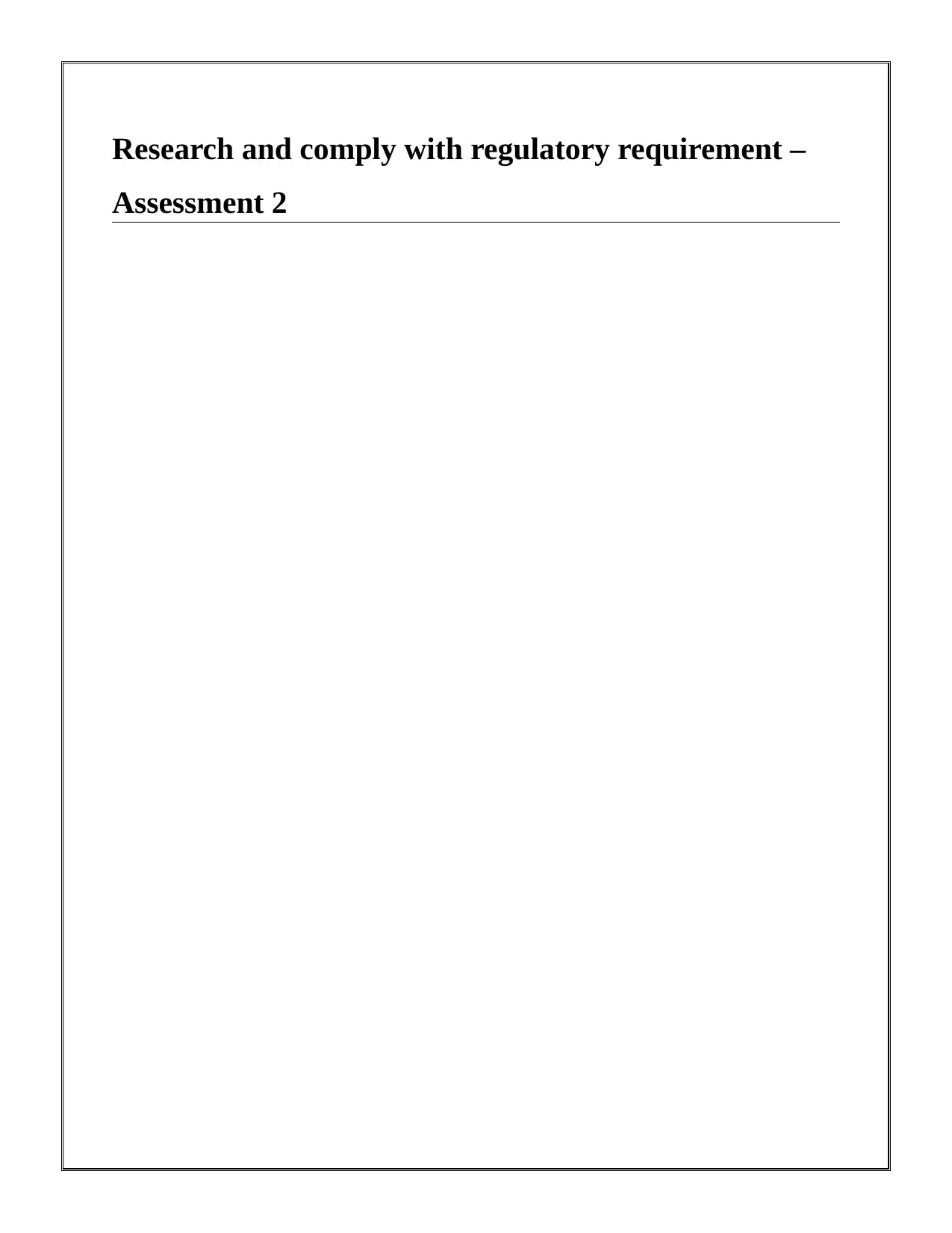
Research and comply with regulatory requirement –
Assessment 2
Assessment 2
Secure Best Marks with AI Grader
Need help grading? Try our AI Grader for instant feedback on your assignments.
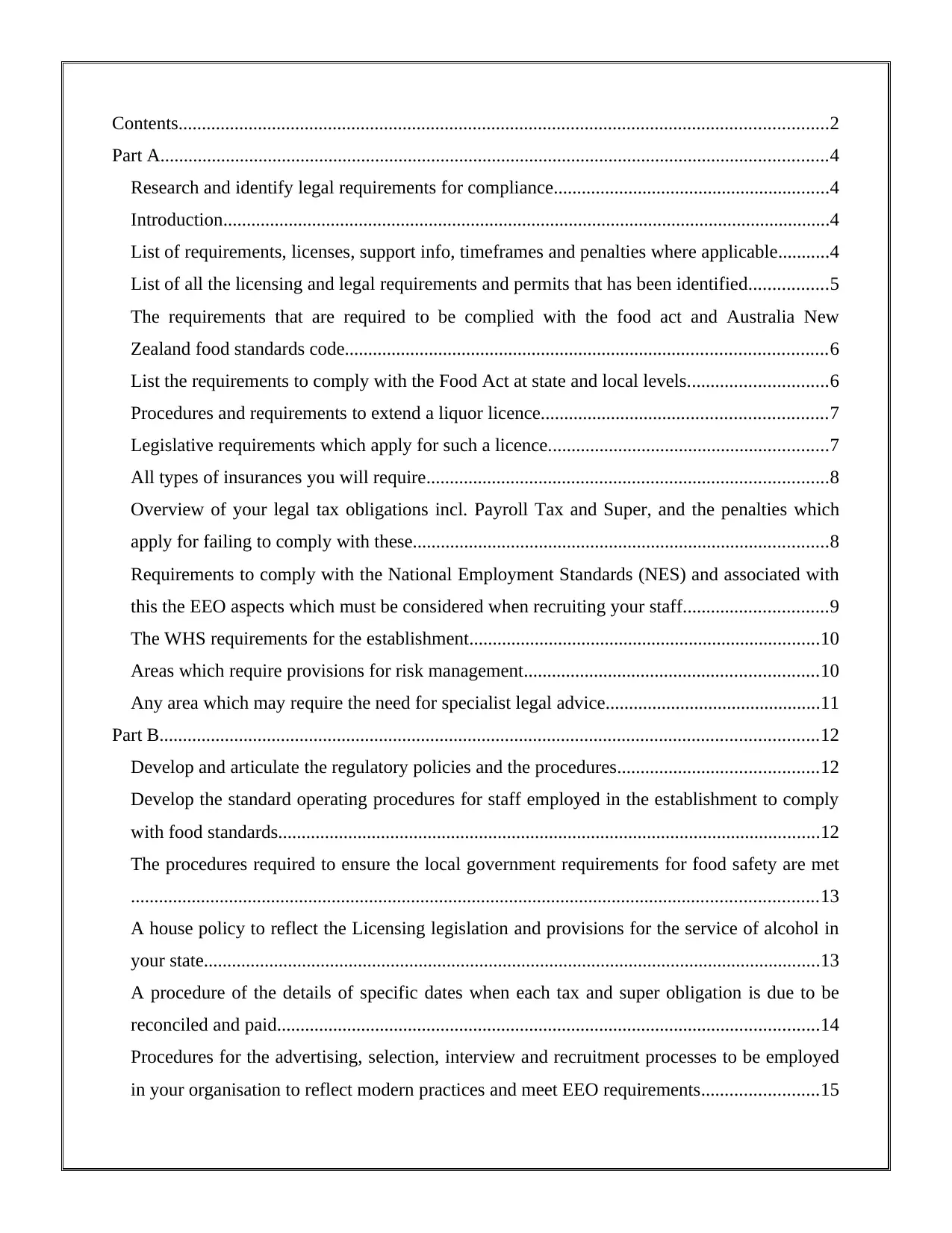
Contents...........................................................................................................................................2
Part A...............................................................................................................................................4
Research and identify legal requirements for compliance...........................................................4
Introduction..................................................................................................................................4
List of requirements, licenses, support info, timeframes and penalties where applicable...........4
List of all the licensing and legal requirements and permits that has been identified.................5
The requirements that are required to be complied with the food act and Australia New
Zealand food standards code.......................................................................................................6
List the requirements to comply with the Food Act at state and local levels..............................6
Procedures and requirements to extend a liquor licence.............................................................7
Legislative requirements which apply for such a licence............................................................7
All types of insurances you will require......................................................................................8
Overview of your legal tax obligations incl. Payroll Tax and Super, and the penalties which
apply for failing to comply with these.........................................................................................8
Requirements to comply with the National Employment Standards (NES) and associated with
this the EEO aspects which must be considered when recruiting your staff...............................9
The WHS requirements for the establishment...........................................................................10
Areas which require provisions for risk management...............................................................10
Any area which may require the need for specialist legal advice..............................................11
Part B.............................................................................................................................................12
Develop and articulate the regulatory policies and the procedures...........................................12
Develop the standard operating procedures for staff employed in the establishment to comply
with food standards....................................................................................................................12
The procedures required to ensure the local government requirements for food safety are met
...................................................................................................................................................13
A house policy to reflect the Licensing legislation and provisions for the service of alcohol in
your state....................................................................................................................................13
A procedure of the details of specific dates when each tax and super obligation is due to be
reconciled and paid....................................................................................................................14
Procedures for the advertising, selection, interview and recruitment processes to be employed
in your organisation to reflect modern practices and meet EEO requirements.........................15
Part A...............................................................................................................................................4
Research and identify legal requirements for compliance...........................................................4
Introduction..................................................................................................................................4
List of requirements, licenses, support info, timeframes and penalties where applicable...........4
List of all the licensing and legal requirements and permits that has been identified.................5
The requirements that are required to be complied with the food act and Australia New
Zealand food standards code.......................................................................................................6
List the requirements to comply with the Food Act at state and local levels..............................6
Procedures and requirements to extend a liquor licence.............................................................7
Legislative requirements which apply for such a licence............................................................7
All types of insurances you will require......................................................................................8
Overview of your legal tax obligations incl. Payroll Tax and Super, and the penalties which
apply for failing to comply with these.........................................................................................8
Requirements to comply with the National Employment Standards (NES) and associated with
this the EEO aspects which must be considered when recruiting your staff...............................9
The WHS requirements for the establishment...........................................................................10
Areas which require provisions for risk management...............................................................10
Any area which may require the need for specialist legal advice..............................................11
Part B.............................................................................................................................................12
Develop and articulate the regulatory policies and the procedures...........................................12
Develop the standard operating procedures for staff employed in the establishment to comply
with food standards....................................................................................................................12
The procedures required to ensure the local government requirements for food safety are met
...................................................................................................................................................13
A house policy to reflect the Licensing legislation and provisions for the service of alcohol in
your state....................................................................................................................................13
A procedure of the details of specific dates when each tax and super obligation is due to be
reconciled and paid....................................................................................................................14
Procedures for the advertising, selection, interview and recruitment processes to be employed
in your organisation to reflect modern practices and meet EEO requirements.........................15
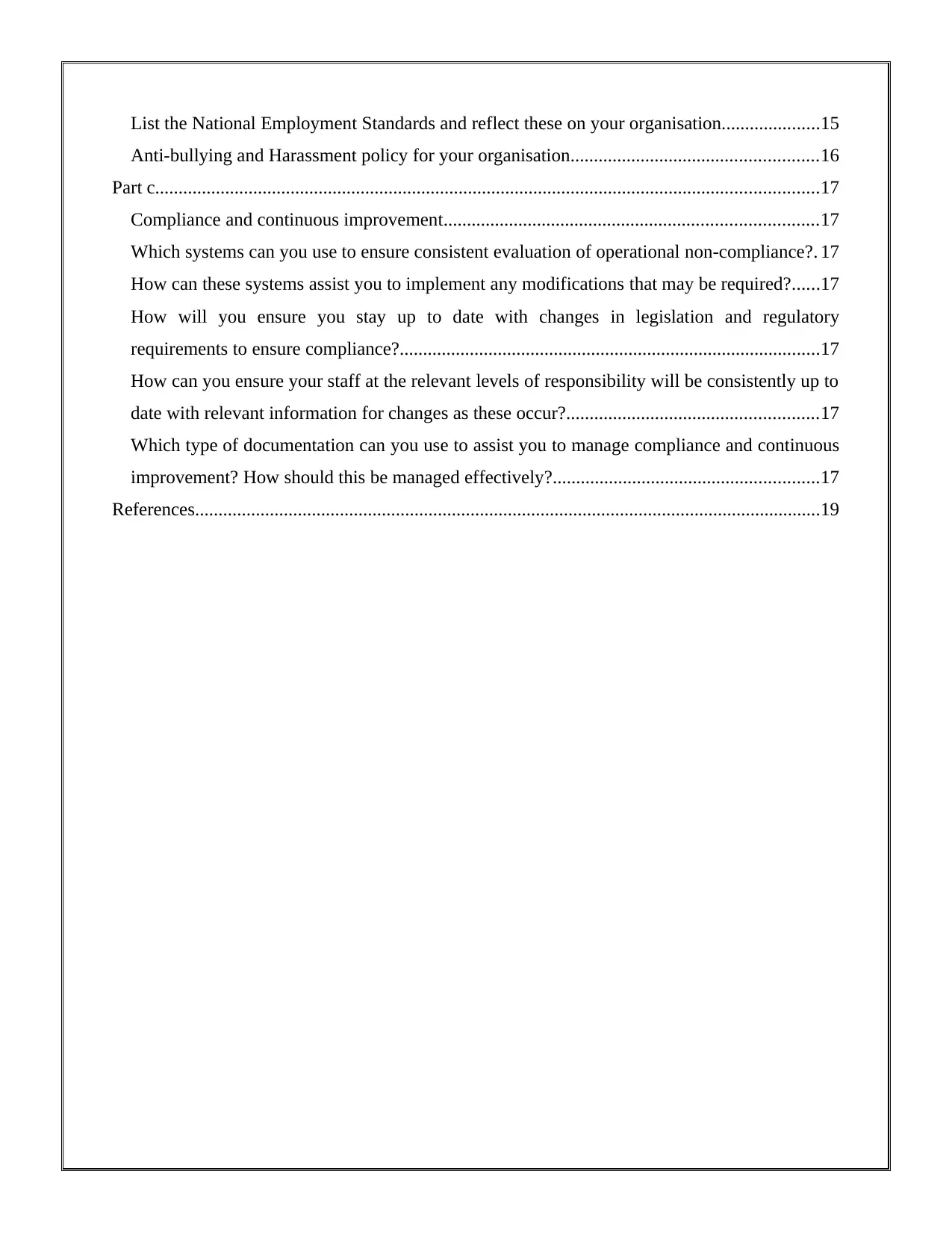
List the National Employment Standards and reflect these on your organisation.....................15
Anti-bullying and Harassment policy for your organisation.....................................................16
Part c..............................................................................................................................................17
Compliance and continuous improvement................................................................................17
Which systems can you use to ensure consistent evaluation of operational non-compliance?. 17
How can these systems assist you to implement any modifications that may be required?......17
How will you ensure you stay up to date with changes in legislation and regulatory
requirements to ensure compliance?..........................................................................................17
How can you ensure your staff at the relevant levels of responsibility will be consistently up to
date with relevant information for changes as these occur?......................................................17
Which type of documentation can you use to assist you to manage compliance and continuous
improvement? How should this be managed effectively?.........................................................17
References......................................................................................................................................19
Anti-bullying and Harassment policy for your organisation.....................................................16
Part c..............................................................................................................................................17
Compliance and continuous improvement................................................................................17
Which systems can you use to ensure consistent evaluation of operational non-compliance?. 17
How can these systems assist you to implement any modifications that may be required?......17
How will you ensure you stay up to date with changes in legislation and regulatory
requirements to ensure compliance?..........................................................................................17
How can you ensure your staff at the relevant levels of responsibility will be consistently up to
date with relevant information for changes as these occur?......................................................17
Which type of documentation can you use to assist you to manage compliance and continuous
improvement? How should this be managed effectively?.........................................................17
References......................................................................................................................................19
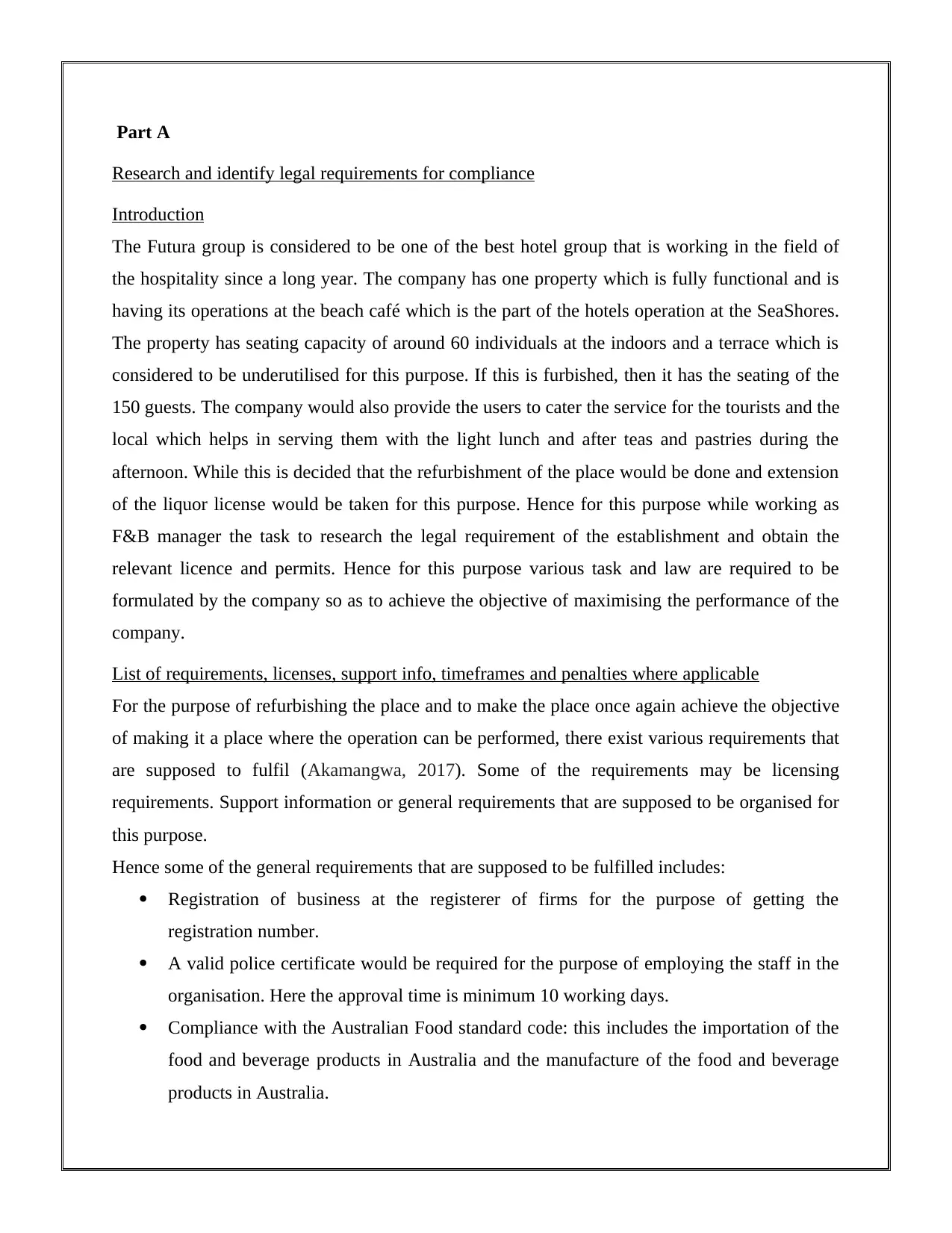
Part A
Research and identify legal requirements for compliance
Introduction
The Futura group is considered to be one of the best hotel group that is working in the field of
the hospitality since a long year. The company has one property which is fully functional and is
having its operations at the beach café which is the part of the hotels operation at the SeaShores.
The property has seating capacity of around 60 individuals at the indoors and a terrace which is
considered to be underutilised for this purpose. If this is furbished, then it has the seating of the
150 guests. The company would also provide the users to cater the service for the tourists and the
local which helps in serving them with the light lunch and after teas and pastries during the
afternoon. While this is decided that the refurbishment of the place would be done and extension
of the liquor license would be taken for this purpose. Hence for this purpose while working as
F&B manager the task to research the legal requirement of the establishment and obtain the
relevant licence and permits. Hence for this purpose various task and law are required to be
formulated by the company so as to achieve the objective of maximising the performance of the
company.
List of requirements, licenses, support info, timeframes and penalties where applicable
For the purpose of refurbishing the place and to make the place once again achieve the objective
of making it a place where the operation can be performed, there exist various requirements that
are supposed to fulfil (Akamangwa, 2017). Some of the requirements may be licensing
requirements. Support information or general requirements that are supposed to be organised for
this purpose.
Hence some of the general requirements that are supposed to be fulfilled includes:
Registration of business at the registerer of firms for the purpose of getting the
registration number.
A valid police certificate would be required for the purpose of employing the staff in the
organisation. Here the approval time is minimum 10 working days.
Compliance with the Australian Food standard code: this includes the importation of the
food and beverage products in Australia and the manufacture of the food and beverage
products in Australia.
Research and identify legal requirements for compliance
Introduction
The Futura group is considered to be one of the best hotel group that is working in the field of
the hospitality since a long year. The company has one property which is fully functional and is
having its operations at the beach café which is the part of the hotels operation at the SeaShores.
The property has seating capacity of around 60 individuals at the indoors and a terrace which is
considered to be underutilised for this purpose. If this is furbished, then it has the seating of the
150 guests. The company would also provide the users to cater the service for the tourists and the
local which helps in serving them with the light lunch and after teas and pastries during the
afternoon. While this is decided that the refurbishment of the place would be done and extension
of the liquor license would be taken for this purpose. Hence for this purpose while working as
F&B manager the task to research the legal requirement of the establishment and obtain the
relevant licence and permits. Hence for this purpose various task and law are required to be
formulated by the company so as to achieve the objective of maximising the performance of the
company.
List of requirements, licenses, support info, timeframes and penalties where applicable
For the purpose of refurbishing the place and to make the place once again achieve the objective
of making it a place where the operation can be performed, there exist various requirements that
are supposed to fulfil (Akamangwa, 2017). Some of the requirements may be licensing
requirements. Support information or general requirements that are supposed to be organised for
this purpose.
Hence some of the general requirements that are supposed to be fulfilled includes:
Registration of business at the registerer of firms for the purpose of getting the
registration number.
A valid police certificate would be required for the purpose of employing the staff in the
organisation. Here the approval time is minimum 10 working days.
Compliance with the Australian Food standard code: this includes the importation of the
food and beverage products in Australia and the manufacture of the food and beverage
products in Australia.
Secure Best Marks with AI Grader
Need help grading? Try our AI Grader for instant feedback on your assignments.
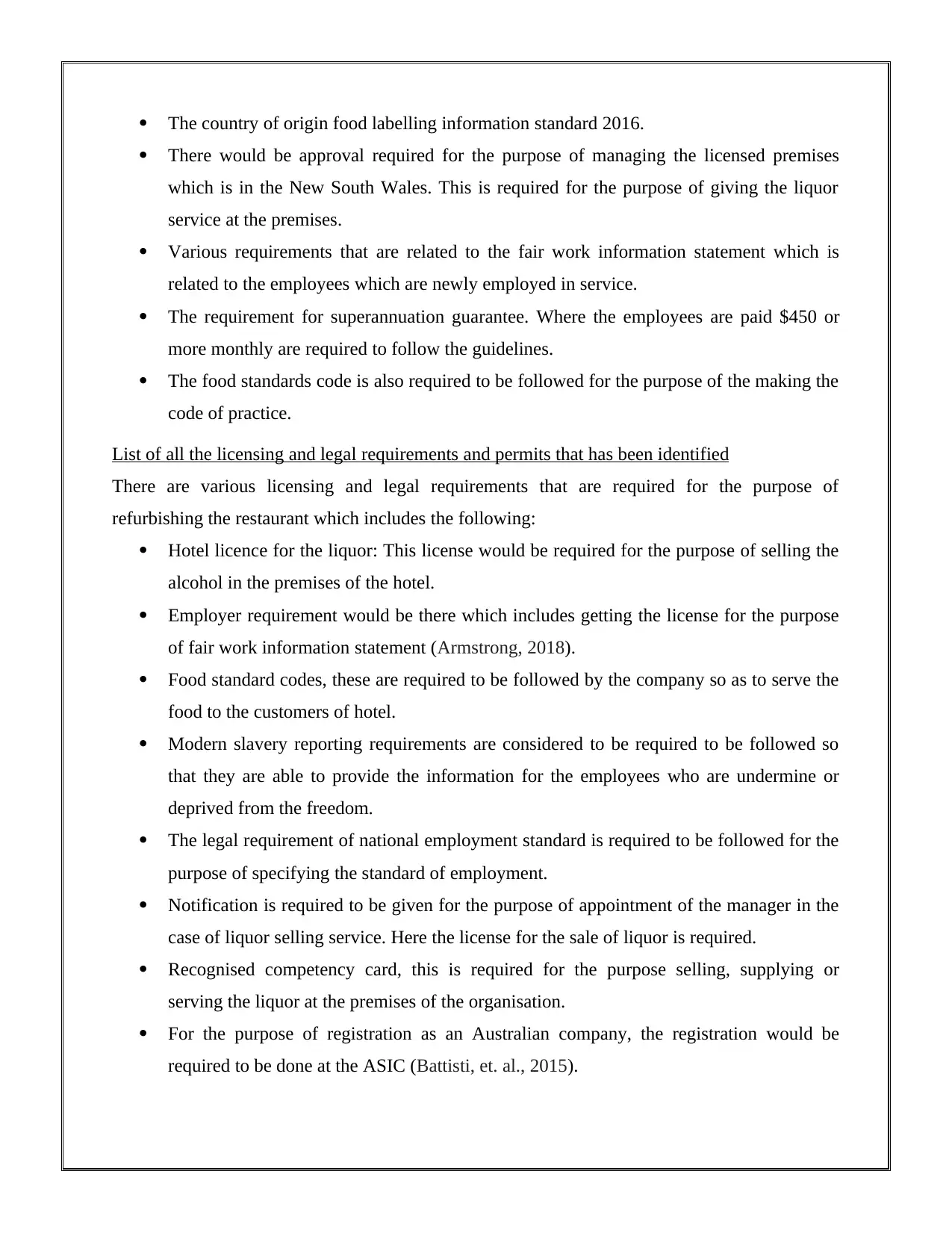
The country of origin food labelling information standard 2016.
There would be approval required for the purpose of managing the licensed premises
which is in the New South Wales. This is required for the purpose of giving the liquor
service at the premises.
Various requirements that are related to the fair work information statement which is
related to the employees which are newly employed in service.
The requirement for superannuation guarantee. Where the employees are paid $450 or
more monthly are required to follow the guidelines.
The food standards code is also required to be followed for the purpose of the making the
code of practice.
List of all the licensing and legal requirements and permits that has been identified
There are various licensing and legal requirements that are required for the purpose of
refurbishing the restaurant which includes the following:
Hotel licence for the liquor: This license would be required for the purpose of selling the
alcohol in the premises of the hotel.
Employer requirement would be there which includes getting the license for the purpose
of fair work information statement (Armstrong, 2018).
Food standard codes, these are required to be followed by the company so as to serve the
food to the customers of hotel.
Modern slavery reporting requirements are considered to be required to be followed so
that they are able to provide the information for the employees who are undermine or
deprived from the freedom.
The legal requirement of national employment standard is required to be followed for the
purpose of specifying the standard of employment.
Notification is required to be given for the purpose of appointment of the manager in the
case of liquor selling service. Here the license for the sale of liquor is required.
Recognised competency card, this is required for the purpose selling, supplying or
serving the liquor at the premises of the organisation.
For the purpose of registration as an Australian company, the registration would be
required to be done at the ASIC (Battisti, et. al., 2015).
There would be approval required for the purpose of managing the licensed premises
which is in the New South Wales. This is required for the purpose of giving the liquor
service at the premises.
Various requirements that are related to the fair work information statement which is
related to the employees which are newly employed in service.
The requirement for superannuation guarantee. Where the employees are paid $450 or
more monthly are required to follow the guidelines.
The food standards code is also required to be followed for the purpose of the making the
code of practice.
List of all the licensing and legal requirements and permits that has been identified
There are various licensing and legal requirements that are required for the purpose of
refurbishing the restaurant which includes the following:
Hotel licence for the liquor: This license would be required for the purpose of selling the
alcohol in the premises of the hotel.
Employer requirement would be there which includes getting the license for the purpose
of fair work information statement (Armstrong, 2018).
Food standard codes, these are required to be followed by the company so as to serve the
food to the customers of hotel.
Modern slavery reporting requirements are considered to be required to be followed so
that they are able to provide the information for the employees who are undermine or
deprived from the freedom.
The legal requirement of national employment standard is required to be followed for the
purpose of specifying the standard of employment.
Notification is required to be given for the purpose of appointment of the manager in the
case of liquor selling service. Here the license for the sale of liquor is required.
Recognised competency card, this is required for the purpose selling, supplying or
serving the liquor at the premises of the organisation.
For the purpose of registration as an Australian company, the registration would be
required to be done at the ASIC (Battisti, et. al., 2015).
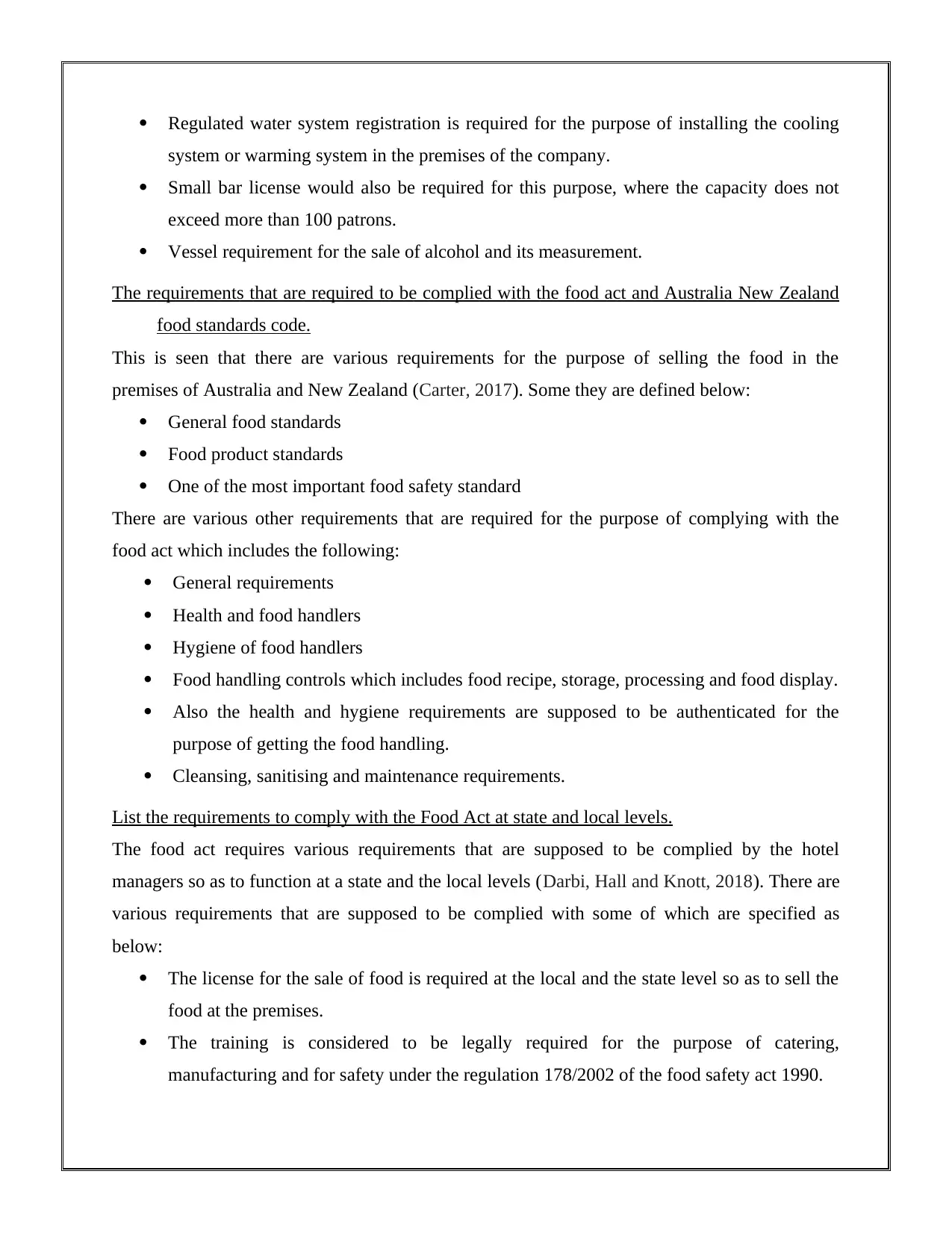
Regulated water system registration is required for the purpose of installing the cooling
system or warming system in the premises of the company.
Small bar license would also be required for this purpose, where the capacity does not
exceed more than 100 patrons.
Vessel requirement for the sale of alcohol and its measurement.
The requirements that are required to be complied with the food act and Australia New Zealand
food standards code.
This is seen that there are various requirements for the purpose of selling the food in the
premises of Australia and New Zealand (Carter, 2017). Some they are defined below:
General food standards
Food product standards
One of the most important food safety standard
There are various other requirements that are required for the purpose of complying with the
food act which includes the following:
General requirements
Health and food handlers
Hygiene of food handlers
Food handling controls which includes food recipe, storage, processing and food display.
Also the health and hygiene requirements are supposed to be authenticated for the
purpose of getting the food handling.
Cleansing, sanitising and maintenance requirements.
List the requirements to comply with the Food Act at state and local levels.
The food act requires various requirements that are supposed to be complied by the hotel
managers so as to function at a state and the local levels (Darbi, Hall and Knott, 2018). There are
various requirements that are supposed to be complied with some of which are specified as
below:
The license for the sale of food is required at the local and the state level so as to sell the
food at the premises.
The training is considered to be legally required for the purpose of catering,
manufacturing and for safety under the regulation 178/2002 of the food safety act 1990.
system or warming system in the premises of the company.
Small bar license would also be required for this purpose, where the capacity does not
exceed more than 100 patrons.
Vessel requirement for the sale of alcohol and its measurement.
The requirements that are required to be complied with the food act and Australia New Zealand
food standards code.
This is seen that there are various requirements for the purpose of selling the food in the
premises of Australia and New Zealand (Carter, 2017). Some they are defined below:
General food standards
Food product standards
One of the most important food safety standard
There are various other requirements that are required for the purpose of complying with the
food act which includes the following:
General requirements
Health and food handlers
Hygiene of food handlers
Food handling controls which includes food recipe, storage, processing and food display.
Also the health and hygiene requirements are supposed to be authenticated for the
purpose of getting the food handling.
Cleansing, sanitising and maintenance requirements.
List the requirements to comply with the Food Act at state and local levels.
The food act requires various requirements that are supposed to be complied by the hotel
managers so as to function at a state and the local levels (Darbi, Hall and Knott, 2018). There are
various requirements that are supposed to be complied with some of which are specified as
below:
The license for the sale of food is required at the local and the state level so as to sell the
food at the premises.
The training is considered to be legally required for the purpose of catering,
manufacturing and for safety under the regulation 178/2002 of the food safety act 1990.
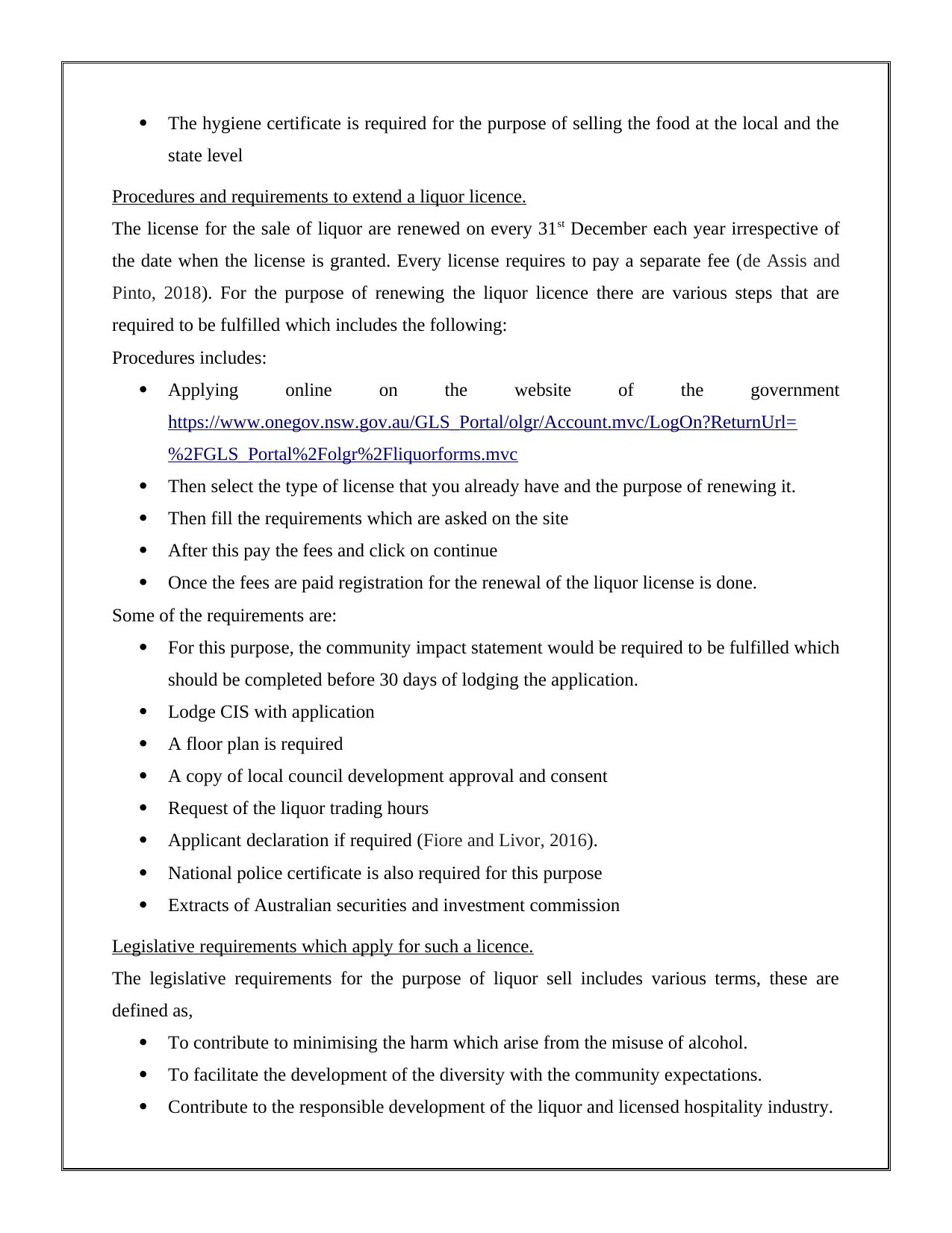
The hygiene certificate is required for the purpose of selling the food at the local and the
state level
Procedures and requirements to extend a liquor licence.
The license for the sale of liquor are renewed on every 31st December each year irrespective of
the date when the license is granted. Every license requires to pay a separate fee (de Assis and
Pinto, 2018). For the purpose of renewing the liquor licence there are various steps that are
required to be fulfilled which includes the following:
Procedures includes:
Applying online on the website of the government
https://www.onegov.nsw.gov.au/GLS_Portal/olgr/Account.mvc/LogOn?ReturnUrl=
%2FGLS_Portal%2Folgr%2Fliquorforms.mvc
Then select the type of license that you already have and the purpose of renewing it.
Then fill the requirements which are asked on the site
After this pay the fees and click on continue
Once the fees are paid registration for the renewal of the liquor license is done.
Some of the requirements are:
For this purpose, the community impact statement would be required to be fulfilled which
should be completed before 30 days of lodging the application.
Lodge CIS with application
A floor plan is required
A copy of local council development approval and consent
Request of the liquor trading hours
Applicant declaration if required (Fiore and Livor, 2016).
National police certificate is also required for this purpose
Extracts of Australian securities and investment commission
Legislative requirements which apply for such a licence.
The legislative requirements for the purpose of liquor sell includes various terms, these are
defined as,
To contribute to minimising the harm which arise from the misuse of alcohol.
To facilitate the development of the diversity with the community expectations.
Contribute to the responsible development of the liquor and licensed hospitality industry.
state level
Procedures and requirements to extend a liquor licence.
The license for the sale of liquor are renewed on every 31st December each year irrespective of
the date when the license is granted. Every license requires to pay a separate fee (de Assis and
Pinto, 2018). For the purpose of renewing the liquor licence there are various steps that are
required to be fulfilled which includes the following:
Procedures includes:
Applying online on the website of the government
https://www.onegov.nsw.gov.au/GLS_Portal/olgr/Account.mvc/LogOn?ReturnUrl=
%2FGLS_Portal%2Folgr%2Fliquorforms.mvc
Then select the type of license that you already have and the purpose of renewing it.
Then fill the requirements which are asked on the site
After this pay the fees and click on continue
Once the fees are paid registration for the renewal of the liquor license is done.
Some of the requirements are:
For this purpose, the community impact statement would be required to be fulfilled which
should be completed before 30 days of lodging the application.
Lodge CIS with application
A floor plan is required
A copy of local council development approval and consent
Request of the liquor trading hours
Applicant declaration if required (Fiore and Livor, 2016).
National police certificate is also required for this purpose
Extracts of Australian securities and investment commission
Legislative requirements which apply for such a licence.
The legislative requirements for the purpose of liquor sell includes various terms, these are
defined as,
To contribute to minimising the harm which arise from the misuse of alcohol.
To facilitate the development of the diversity with the community expectations.
Contribute to the responsible development of the liquor and licensed hospitality industry.
Paraphrase This Document
Need a fresh take? Get an instant paraphrase of this document with our AI Paraphraser
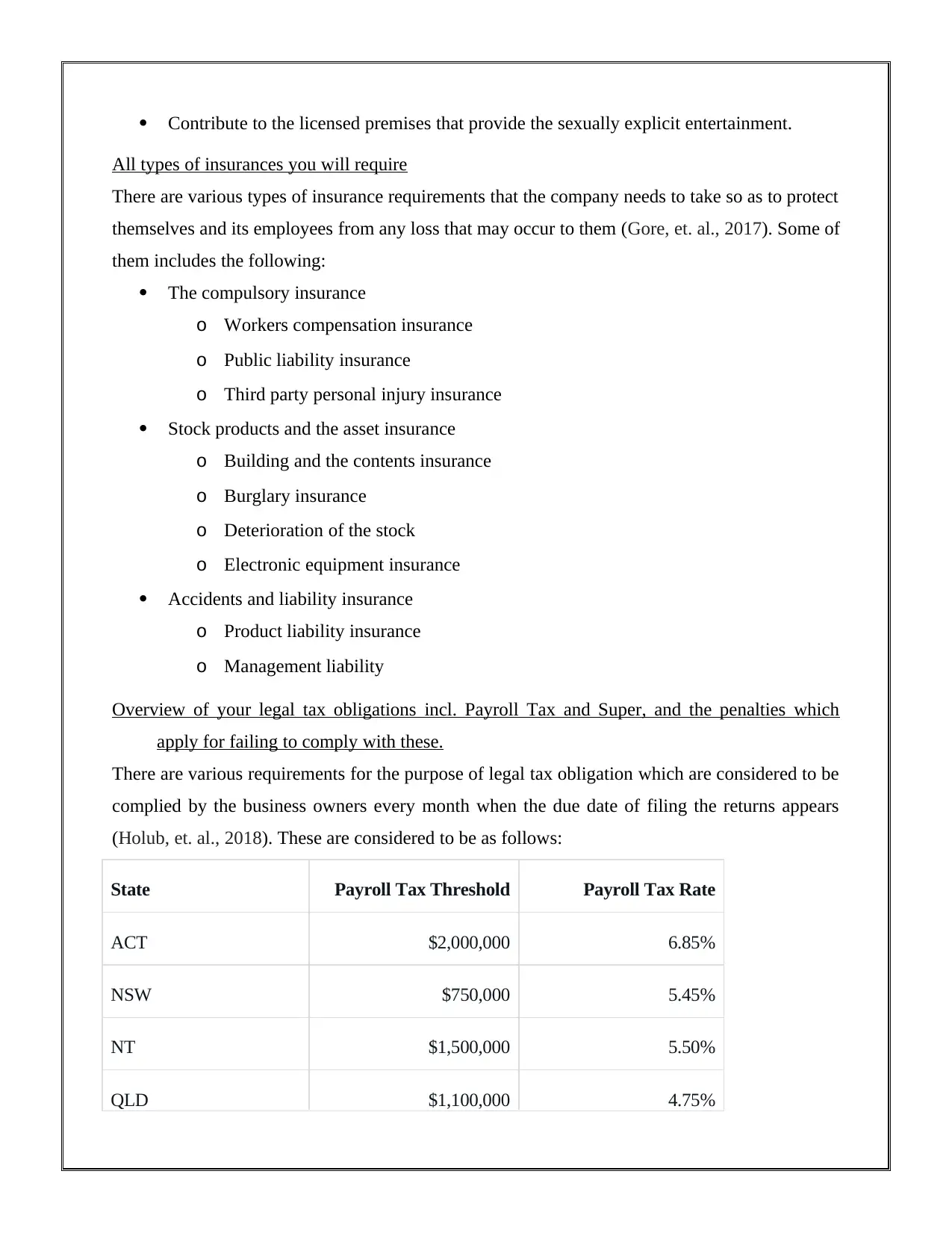
Contribute to the licensed premises that provide the sexually explicit entertainment.
All types of insurances you will require
There are various types of insurance requirements that the company needs to take so as to protect
themselves and its employees from any loss that may occur to them (Gore, et. al., 2017). Some of
them includes the following:
The compulsory insurance
o Workers compensation insurance
o Public liability insurance
o Third party personal injury insurance
Stock products and the asset insurance
o Building and the contents insurance
o Burglary insurance
o Deterioration of the stock
o Electronic equipment insurance
Accidents and liability insurance
o Product liability insurance
o Management liability
Overview of your legal tax obligations incl. Payroll Tax and Super, and the penalties which
apply for failing to comply with these.
There are various requirements for the purpose of legal tax obligation which are considered to be
complied by the business owners every month when the due date of filing the returns appears
(Holub, et. al., 2018). These are considered to be as follows:
State Payroll Tax Threshold Payroll Tax Rate
ACT $2,000,000 6.85%
NSW $750,000 5.45%
NT $1,500,000 5.50%
QLD $1,100,000 4.75%
All types of insurances you will require
There are various types of insurance requirements that the company needs to take so as to protect
themselves and its employees from any loss that may occur to them (Gore, et. al., 2017). Some of
them includes the following:
The compulsory insurance
o Workers compensation insurance
o Public liability insurance
o Third party personal injury insurance
Stock products and the asset insurance
o Building and the contents insurance
o Burglary insurance
o Deterioration of the stock
o Electronic equipment insurance
Accidents and liability insurance
o Product liability insurance
o Management liability
Overview of your legal tax obligations incl. Payroll Tax and Super, and the penalties which
apply for failing to comply with these.
There are various requirements for the purpose of legal tax obligation which are considered to be
complied by the business owners every month when the due date of filing the returns appears
(Holub, et. al., 2018). These are considered to be as follows:
State Payroll Tax Threshold Payroll Tax Rate
ACT $2,000,000 6.85%
NSW $750,000 5.45%
NT $1,500,000 5.50%
QLD $1,100,000 4.75%
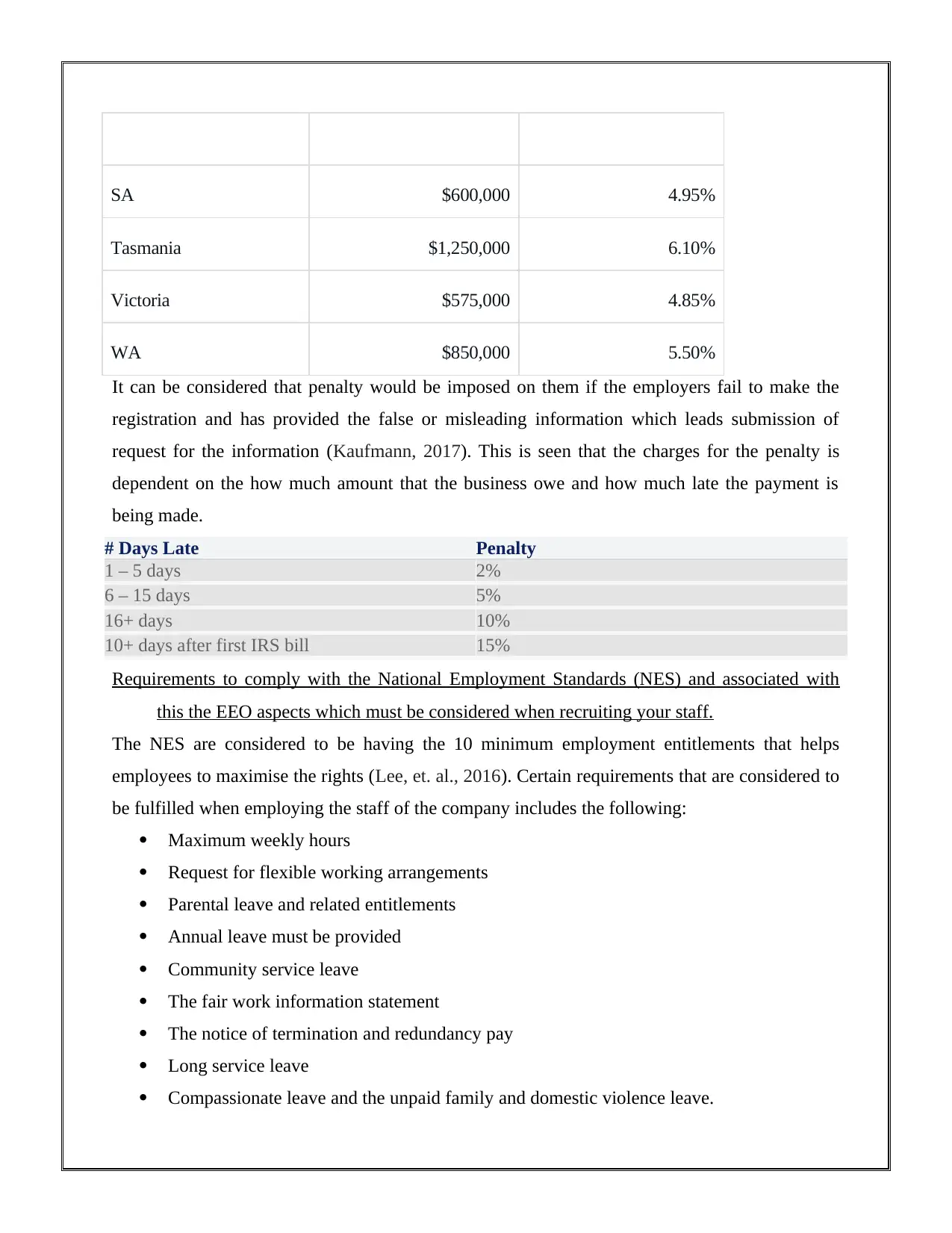
SA $600,000 4.95%
Tasmania $1,250,000 6.10%
Victoria $575,000 4.85%
WA $850,000 5.50%
It can be considered that penalty would be imposed on them if the employers fail to make the
registration and has provided the false or misleading information which leads submission of
request for the information (Kaufmann, 2017). This is seen that the charges for the penalty is
dependent on the how much amount that the business owe and how much late the payment is
being made.
# Days Late Penalty
1 – 5 days 2%
6 – 15 days 5%
16+ days 10%
10+ days after first IRS bill 15%
Requirements to comply with the National Employment Standards (NES) and associated with
this the EEO aspects which must be considered when recruiting your staff.
The NES are considered to be having the 10 minimum employment entitlements that helps
employees to maximise the rights (Lee, et. al., 2016). Certain requirements that are considered to
be fulfilled when employing the staff of the company includes the following:
Maximum weekly hours
Request for flexible working arrangements
Parental leave and related entitlements
Annual leave must be provided
Community service leave
The fair work information statement
The notice of termination and redundancy pay
Long service leave
Compassionate leave and the unpaid family and domestic violence leave.
Tasmania $1,250,000 6.10%
Victoria $575,000 4.85%
WA $850,000 5.50%
It can be considered that penalty would be imposed on them if the employers fail to make the
registration and has provided the false or misleading information which leads submission of
request for the information (Kaufmann, 2017). This is seen that the charges for the penalty is
dependent on the how much amount that the business owe and how much late the payment is
being made.
# Days Late Penalty
1 – 5 days 2%
6 – 15 days 5%
16+ days 10%
10+ days after first IRS bill 15%
Requirements to comply with the National Employment Standards (NES) and associated with
this the EEO aspects which must be considered when recruiting your staff.
The NES are considered to be having the 10 minimum employment entitlements that helps
employees to maximise the rights (Lee, et. al., 2016). Certain requirements that are considered to
be fulfilled when employing the staff of the company includes the following:
Maximum weekly hours
Request for flexible working arrangements
Parental leave and related entitlements
Annual leave must be provided
Community service leave
The fair work information statement
The notice of termination and redundancy pay
Long service leave
Compassionate leave and the unpaid family and domestic violence leave.
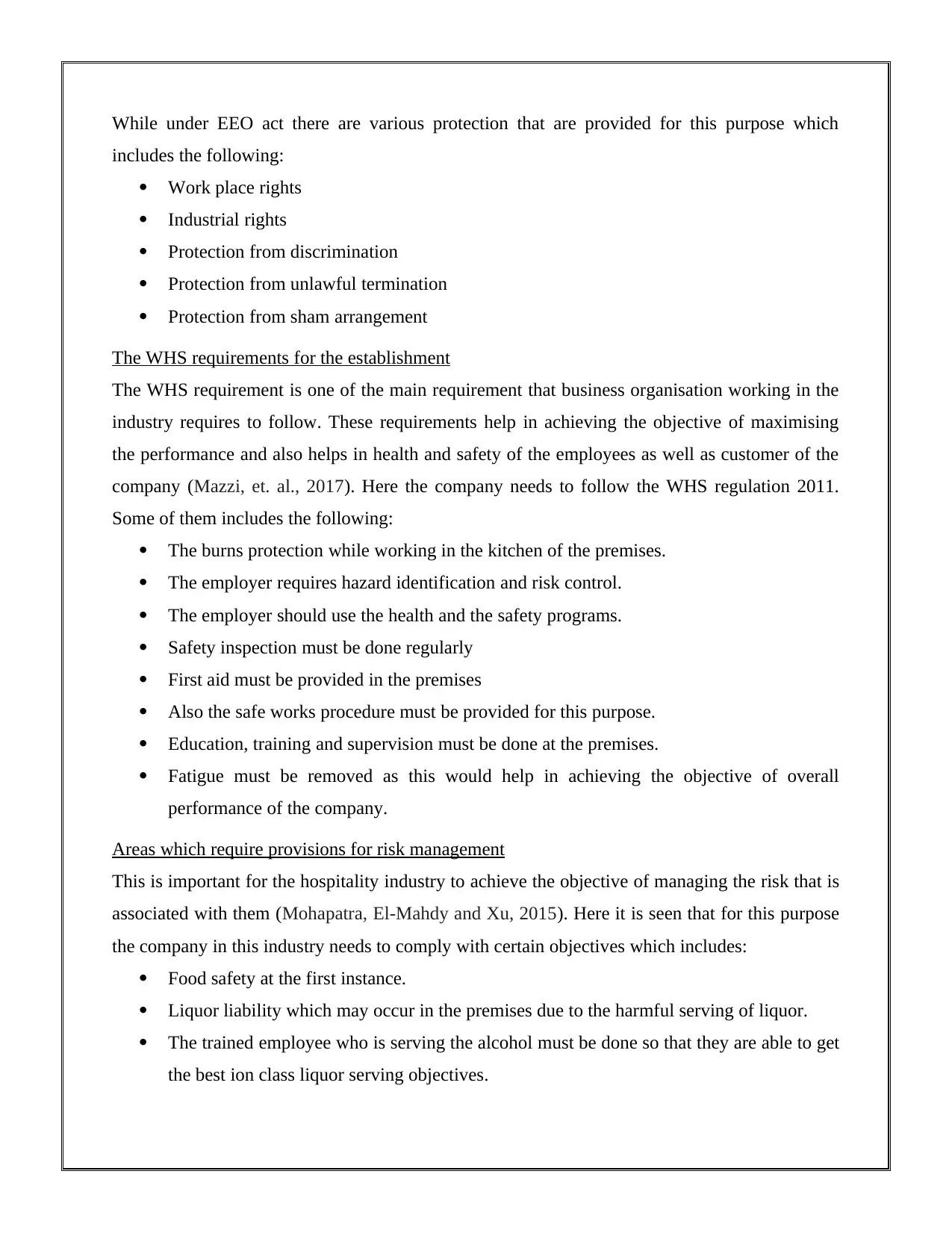
While under EEO act there are various protection that are provided for this purpose which
includes the following:
Work place rights
Industrial rights
Protection from discrimination
Protection from unlawful termination
Protection from sham arrangement
The WHS requirements for the establishment
The WHS requirement is one of the main requirement that business organisation working in the
industry requires to follow. These requirements help in achieving the objective of maximising
the performance and also helps in health and safety of the employees as well as customer of the
company (Mazzi, et. al., 2017). Here the company needs to follow the WHS regulation 2011.
Some of them includes the following:
The burns protection while working in the kitchen of the premises.
The employer requires hazard identification and risk control.
The employer should use the health and the safety programs.
Safety inspection must be done regularly
First aid must be provided in the premises
Also the safe works procedure must be provided for this purpose.
Education, training and supervision must be done at the premises.
Fatigue must be removed as this would help in achieving the objective of overall
performance of the company.
Areas which require provisions for risk management
This is important for the hospitality industry to achieve the objective of managing the risk that is
associated with them (Mohapatra, El-Mahdy and Xu, 2015). Here it is seen that for this purpose
the company in this industry needs to comply with certain objectives which includes:
Food safety at the first instance.
Liquor liability which may occur in the premises due to the harmful serving of liquor.
The trained employee who is serving the alcohol must be done so that they are able to get
the best ion class liquor serving objectives.
includes the following:
Work place rights
Industrial rights
Protection from discrimination
Protection from unlawful termination
Protection from sham arrangement
The WHS requirements for the establishment
The WHS requirement is one of the main requirement that business organisation working in the
industry requires to follow. These requirements help in achieving the objective of maximising
the performance and also helps in health and safety of the employees as well as customer of the
company (Mazzi, et. al., 2017). Here the company needs to follow the WHS regulation 2011.
Some of them includes the following:
The burns protection while working in the kitchen of the premises.
The employer requires hazard identification and risk control.
The employer should use the health and the safety programs.
Safety inspection must be done regularly
First aid must be provided in the premises
Also the safe works procedure must be provided for this purpose.
Education, training and supervision must be done at the premises.
Fatigue must be removed as this would help in achieving the objective of overall
performance of the company.
Areas which require provisions for risk management
This is important for the hospitality industry to achieve the objective of managing the risk that is
associated with them (Mohapatra, El-Mahdy and Xu, 2015). Here it is seen that for this purpose
the company in this industry needs to comply with certain objectives which includes:
Food safety at the first instance.
Liquor liability which may occur in the premises due to the harmful serving of liquor.
The trained employee who is serving the alcohol must be done so that they are able to get
the best ion class liquor serving objectives.
Secure Best Marks with AI Grader
Need help grading? Try our AI Grader for instant feedback on your assignments.
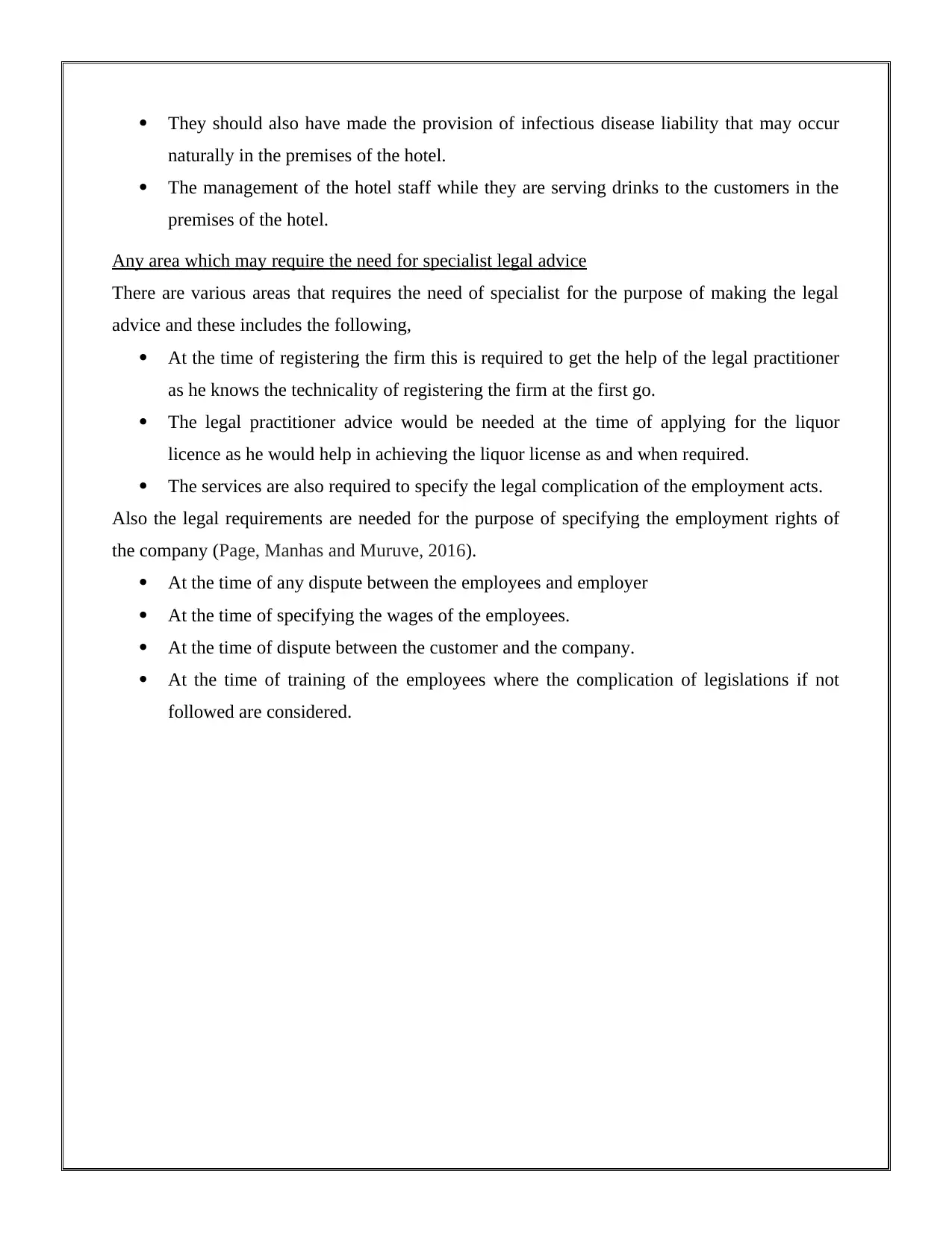
They should also have made the provision of infectious disease liability that may occur
naturally in the premises of the hotel.
The management of the hotel staff while they are serving drinks to the customers in the
premises of the hotel.
Any area which may require the need for specialist legal advice
There are various areas that requires the need of specialist for the purpose of making the legal
advice and these includes the following,
At the time of registering the firm this is required to get the help of the legal practitioner
as he knows the technicality of registering the firm at the first go.
The legal practitioner advice would be needed at the time of applying for the liquor
licence as he would help in achieving the liquor license as and when required.
The services are also required to specify the legal complication of the employment acts.
Also the legal requirements are needed for the purpose of specifying the employment rights of
the company (Page, Manhas and Muruve, 2016).
At the time of any dispute between the employees and employer
At the time of specifying the wages of the employees.
At the time of dispute between the customer and the company.
At the time of training of the employees where the complication of legislations if not
followed are considered.
naturally in the premises of the hotel.
The management of the hotel staff while they are serving drinks to the customers in the
premises of the hotel.
Any area which may require the need for specialist legal advice
There are various areas that requires the need of specialist for the purpose of making the legal
advice and these includes the following,
At the time of registering the firm this is required to get the help of the legal practitioner
as he knows the technicality of registering the firm at the first go.
The legal practitioner advice would be needed at the time of applying for the liquor
licence as he would help in achieving the liquor license as and when required.
The services are also required to specify the legal complication of the employment acts.
Also the legal requirements are needed for the purpose of specifying the employment rights of
the company (Page, Manhas and Muruve, 2016).
At the time of any dispute between the employees and employer
At the time of specifying the wages of the employees.
At the time of dispute between the customer and the company.
At the time of training of the employees where the complication of legislations if not
followed are considered.
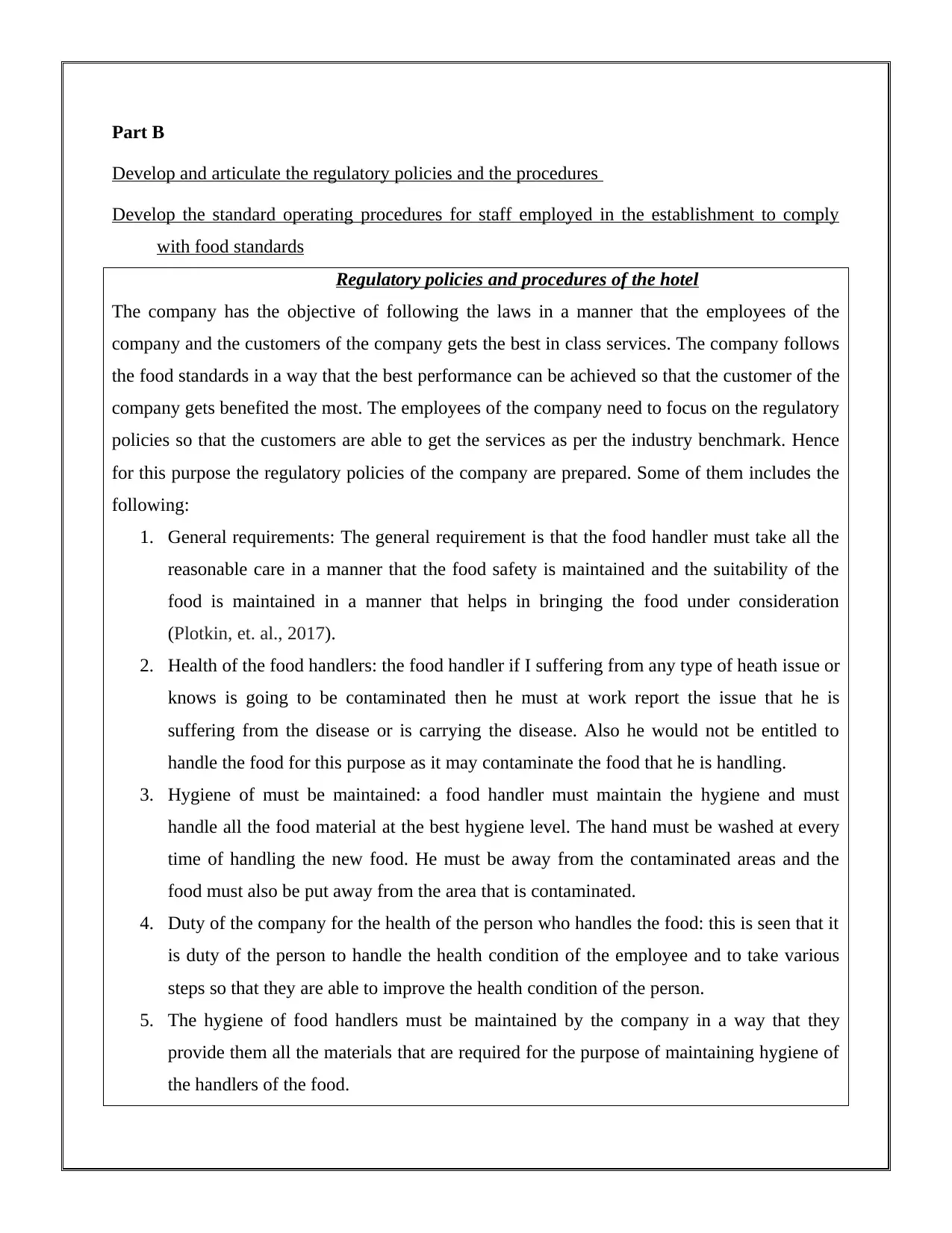
Part B
Develop and articulate the regulatory policies and the procedures
Develop the standard operating procedures for staff employed in the establishment to comply
with food standards
Regulatory policies and procedures of the hotel
The company has the objective of following the laws in a manner that the employees of the
company and the customers of the company gets the best in class services. The company follows
the food standards in a way that the best performance can be achieved so that the customer of the
company gets benefited the most. The employees of the company need to focus on the regulatory
policies so that the customers are able to get the services as per the industry benchmark. Hence
for this purpose the regulatory policies of the company are prepared. Some of them includes the
following:
1. General requirements: The general requirement is that the food handler must take all the
reasonable care in a manner that the food safety is maintained and the suitability of the
food is maintained in a manner that helps in bringing the food under consideration
(Plotkin, et. al., 2017).
2. Health of the food handlers: the food handler if I suffering from any type of heath issue or
knows is going to be contaminated then he must at work report the issue that he is
suffering from the disease or is carrying the disease. Also he would not be entitled to
handle the food for this purpose as it may contaminate the food that he is handling.
3. Hygiene of must be maintained: a food handler must maintain the hygiene and must
handle all the food material at the best hygiene level. The hand must be washed at every
time of handling the new food. He must be away from the contaminated areas and the
food must also be put away from the area that is contaminated.
4. Duty of the company for the health of the person who handles the food: this is seen that it
is duty of the person to handle the health condition of the employee and to take various
steps so that they are able to improve the health condition of the person.
5. The hygiene of food handlers must be maintained by the company in a way that they
provide them all the materials that are required for the purpose of maintaining hygiene of
the handlers of the food.
Develop and articulate the regulatory policies and the procedures
Develop the standard operating procedures for staff employed in the establishment to comply
with food standards
Regulatory policies and procedures of the hotel
The company has the objective of following the laws in a manner that the employees of the
company and the customers of the company gets the best in class services. The company follows
the food standards in a way that the best performance can be achieved so that the customer of the
company gets benefited the most. The employees of the company need to focus on the regulatory
policies so that the customers are able to get the services as per the industry benchmark. Hence
for this purpose the regulatory policies of the company are prepared. Some of them includes the
following:
1. General requirements: The general requirement is that the food handler must take all the
reasonable care in a manner that the food safety is maintained and the suitability of the
food is maintained in a manner that helps in bringing the food under consideration
(Plotkin, et. al., 2017).
2. Health of the food handlers: the food handler if I suffering from any type of heath issue or
knows is going to be contaminated then he must at work report the issue that he is
suffering from the disease or is carrying the disease. Also he would not be entitled to
handle the food for this purpose as it may contaminate the food that he is handling.
3. Hygiene of must be maintained: a food handler must maintain the hygiene and must
handle all the food material at the best hygiene level. The hand must be washed at every
time of handling the new food. He must be away from the contaminated areas and the
food must also be put away from the area that is contaminated.
4. Duty of the company for the health of the person who handles the food: this is seen that it
is duty of the person to handle the health condition of the employee and to take various
steps so that they are able to improve the health condition of the person.
5. The hygiene of food handlers must be maintained by the company in a way that they
provide them all the materials that are required for the purpose of maintaining hygiene of
the handlers of the food.
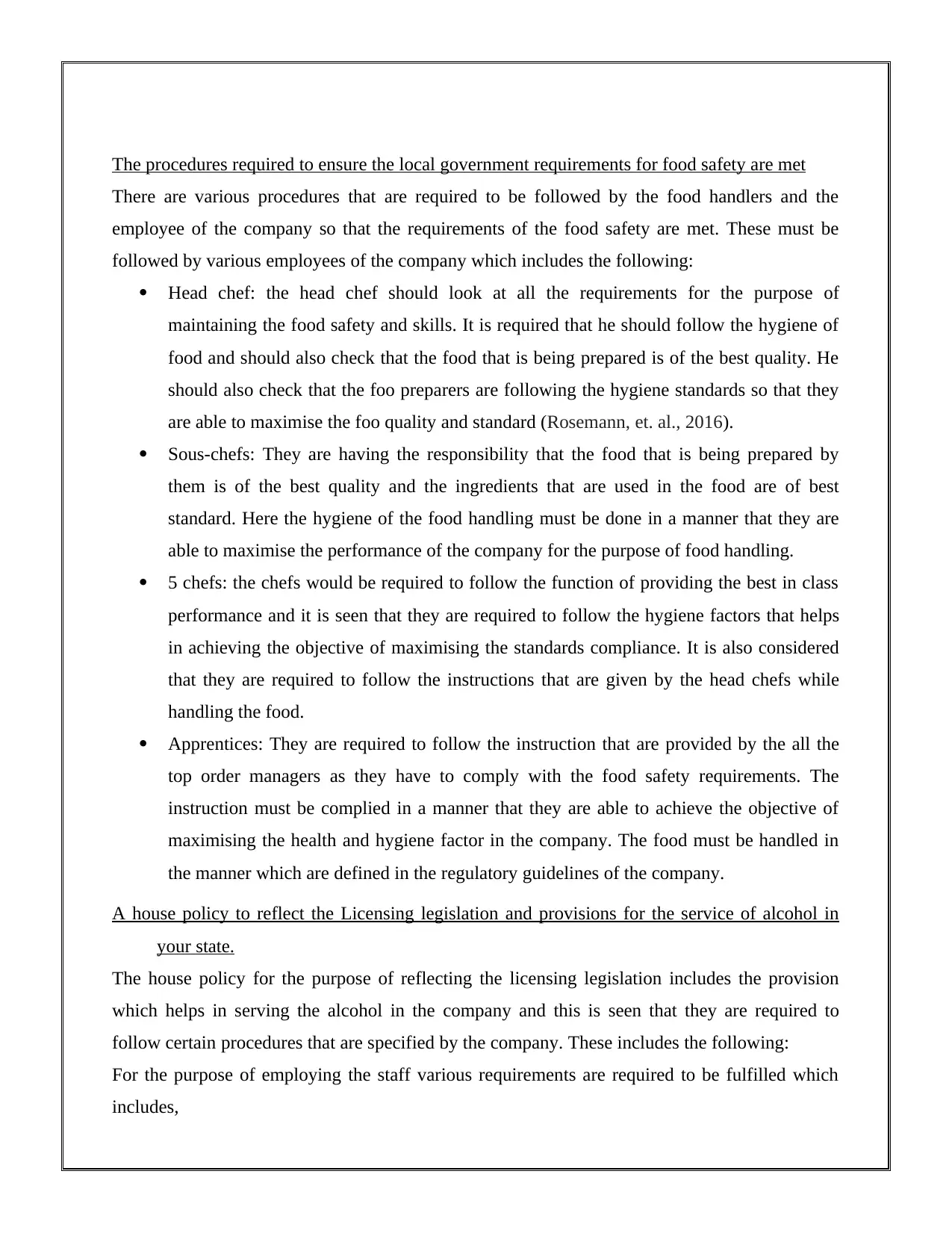
The procedures required to ensure the local government requirements for food safety are met
There are various procedures that are required to be followed by the food handlers and the
employee of the company so that the requirements of the food safety are met. These must be
followed by various employees of the company which includes the following:
Head chef: the head chef should look at all the requirements for the purpose of
maintaining the food safety and skills. It is required that he should follow the hygiene of
food and should also check that the food that is being prepared is of the best quality. He
should also check that the foo preparers are following the hygiene standards so that they
are able to maximise the foo quality and standard (Rosemann, et. al., 2016).
Sous-chefs: They are having the responsibility that the food that is being prepared by
them is of the best quality and the ingredients that are used in the food are of best
standard. Here the hygiene of the food handling must be done in a manner that they are
able to maximise the performance of the company for the purpose of food handling.
5 chefs: the chefs would be required to follow the function of providing the best in class
performance and it is seen that they are required to follow the hygiene factors that helps
in achieving the objective of maximising the standards compliance. It is also considered
that they are required to follow the instructions that are given by the head chefs while
handling the food.
Apprentices: They are required to follow the instruction that are provided by the all the
top order managers as they have to comply with the food safety requirements. The
instruction must be complied in a manner that they are able to achieve the objective of
maximising the health and hygiene factor in the company. The food must be handled in
the manner which are defined in the regulatory guidelines of the company.
A house policy to reflect the Licensing legislation and provisions for the service of alcohol in
your state.
The house policy for the purpose of reflecting the licensing legislation includes the provision
which helps in serving the alcohol in the company and this is seen that they are required to
follow certain procedures that are specified by the company. These includes the following:
For the purpose of employing the staff various requirements are required to be fulfilled which
includes,
There are various procedures that are required to be followed by the food handlers and the
employee of the company so that the requirements of the food safety are met. These must be
followed by various employees of the company which includes the following:
Head chef: the head chef should look at all the requirements for the purpose of
maintaining the food safety and skills. It is required that he should follow the hygiene of
food and should also check that the food that is being prepared is of the best quality. He
should also check that the foo preparers are following the hygiene standards so that they
are able to maximise the foo quality and standard (Rosemann, et. al., 2016).
Sous-chefs: They are having the responsibility that the food that is being prepared by
them is of the best quality and the ingredients that are used in the food are of best
standard. Here the hygiene of the food handling must be done in a manner that they are
able to maximise the performance of the company for the purpose of food handling.
5 chefs: the chefs would be required to follow the function of providing the best in class
performance and it is seen that they are required to follow the hygiene factors that helps
in achieving the objective of maximising the standards compliance. It is also considered
that they are required to follow the instructions that are given by the head chefs while
handling the food.
Apprentices: They are required to follow the instruction that are provided by the all the
top order managers as they have to comply with the food safety requirements. The
instruction must be complied in a manner that they are able to achieve the objective of
maximising the health and hygiene factor in the company. The food must be handled in
the manner which are defined in the regulatory guidelines of the company.
A house policy to reflect the Licensing legislation and provisions for the service of alcohol in
your state.
The house policy for the purpose of reflecting the licensing legislation includes the provision
which helps in serving the alcohol in the company and this is seen that they are required to
follow certain procedures that are specified by the company. These includes the following:
For the purpose of employing the staff various requirements are required to be fulfilled which
includes,
Paraphrase This Document
Need a fresh take? Get an instant paraphrase of this document with our AI Paraphraser
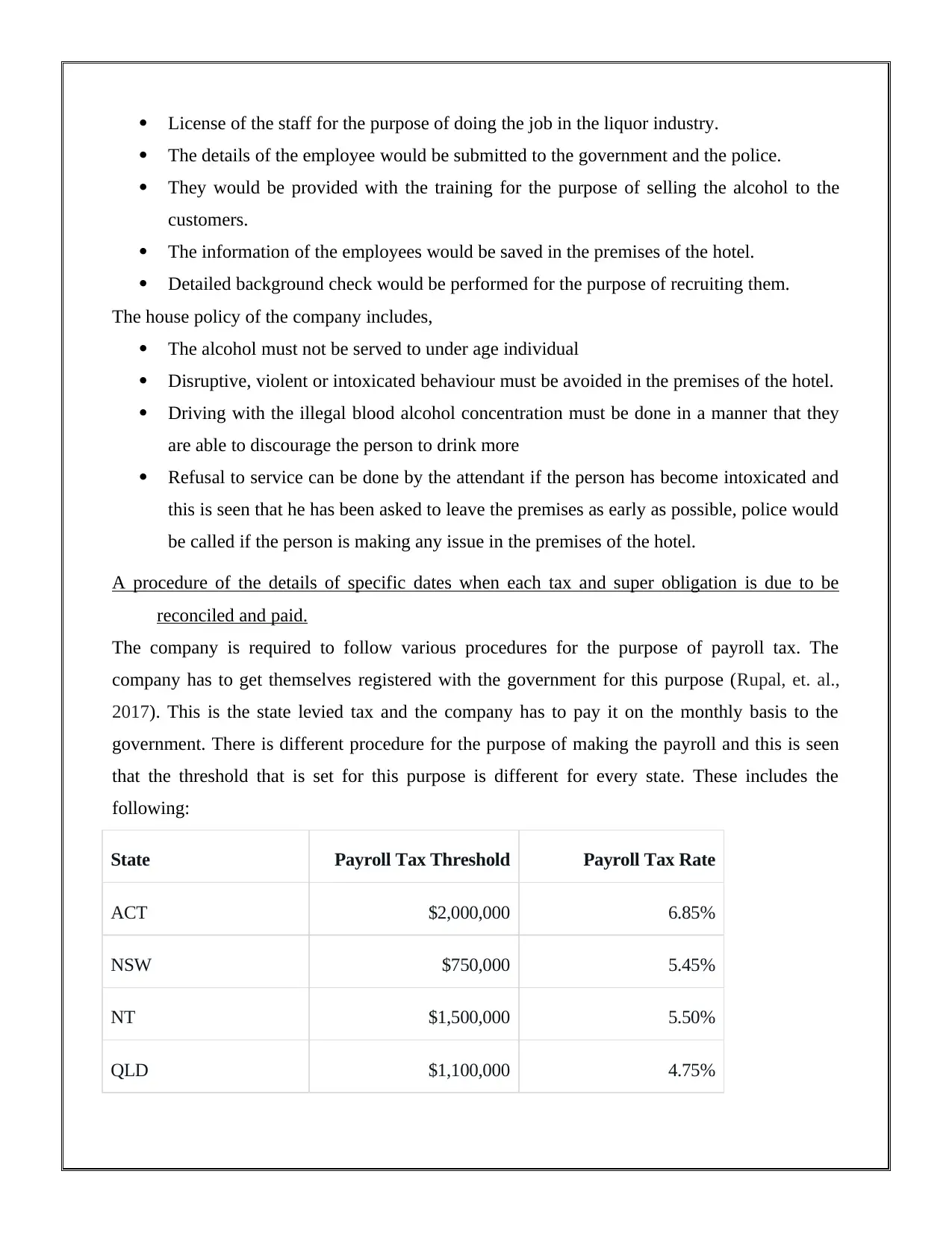
License of the staff for the purpose of doing the job in the liquor industry.
The details of the employee would be submitted to the government and the police.
They would be provided with the training for the purpose of selling the alcohol to the
customers.
The information of the employees would be saved in the premises of the hotel.
Detailed background check would be performed for the purpose of recruiting them.
The house policy of the company includes,
The alcohol must not be served to under age individual
Disruptive, violent or intoxicated behaviour must be avoided in the premises of the hotel.
Driving with the illegal blood alcohol concentration must be done in a manner that they
are able to discourage the person to drink more
Refusal to service can be done by the attendant if the person has become intoxicated and
this is seen that he has been asked to leave the premises as early as possible, police would
be called if the person is making any issue in the premises of the hotel.
A procedure of the details of specific dates when each tax and super obligation is due to be
reconciled and paid.
The company is required to follow various procedures for the purpose of payroll tax. The
company has to get themselves registered with the government for this purpose (Rupal, et. al.,
2017). This is the state levied tax and the company has to pay it on the monthly basis to the
government. There is different procedure for the purpose of making the payroll and this is seen
that the threshold that is set for this purpose is different for every state. These includes the
following:
State Payroll Tax Threshold Payroll Tax Rate
ACT $2,000,000 6.85%
NSW $750,000 5.45%
NT $1,500,000 5.50%
QLD $1,100,000 4.75%
The details of the employee would be submitted to the government and the police.
They would be provided with the training for the purpose of selling the alcohol to the
customers.
The information of the employees would be saved in the premises of the hotel.
Detailed background check would be performed for the purpose of recruiting them.
The house policy of the company includes,
The alcohol must not be served to under age individual
Disruptive, violent or intoxicated behaviour must be avoided in the premises of the hotel.
Driving with the illegal blood alcohol concentration must be done in a manner that they
are able to discourage the person to drink more
Refusal to service can be done by the attendant if the person has become intoxicated and
this is seen that he has been asked to leave the premises as early as possible, police would
be called if the person is making any issue in the premises of the hotel.
A procedure of the details of specific dates when each tax and super obligation is due to be
reconciled and paid.
The company is required to follow various procedures for the purpose of payroll tax. The
company has to get themselves registered with the government for this purpose (Rupal, et. al.,
2017). This is the state levied tax and the company has to pay it on the monthly basis to the
government. There is different procedure for the purpose of making the payroll and this is seen
that the threshold that is set for this purpose is different for every state. These includes the
following:
State Payroll Tax Threshold Payroll Tax Rate
ACT $2,000,000 6.85%
NSW $750,000 5.45%
NT $1,500,000 5.50%
QLD $1,100,000 4.75%
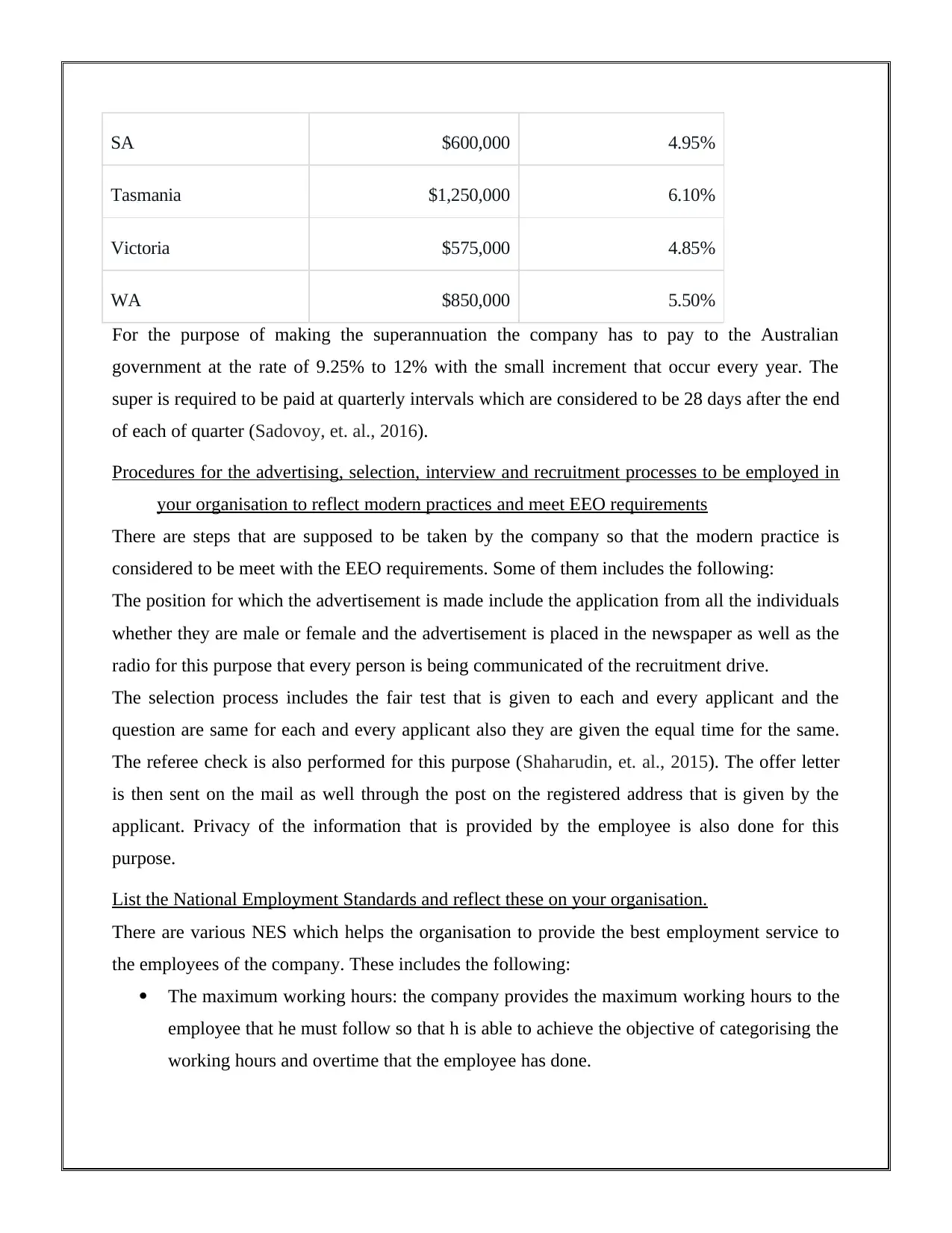
SA $600,000 4.95%
Tasmania $1,250,000 6.10%
Victoria $575,000 4.85%
WA $850,000 5.50%
For the purpose of making the superannuation the company has to pay to the Australian
government at the rate of 9.25% to 12% with the small increment that occur every year. The
super is required to be paid at quarterly intervals which are considered to be 28 days after the end
of each of quarter (Sadovoy, et. al., 2016).
Procedures for the advertising, selection, interview and recruitment processes to be employed in
your organisation to reflect modern practices and meet EEO requirements
There are steps that are supposed to be taken by the company so that the modern practice is
considered to be meet with the EEO requirements. Some of them includes the following:
The position for which the advertisement is made include the application from all the individuals
whether they are male or female and the advertisement is placed in the newspaper as well as the
radio for this purpose that every person is being communicated of the recruitment drive.
The selection process includes the fair test that is given to each and every applicant and the
question are same for each and every applicant also they are given the equal time for the same.
The referee check is also performed for this purpose (Shaharudin, et. al., 2015). The offer letter
is then sent on the mail as well through the post on the registered address that is given by the
applicant. Privacy of the information that is provided by the employee is also done for this
purpose.
List the National Employment Standards and reflect these on your organisation.
There are various NES which helps the organisation to provide the best employment service to
the employees of the company. These includes the following:
The maximum working hours: the company provides the maximum working hours to the
employee that he must follow so that h is able to achieve the objective of categorising the
working hours and overtime that the employee has done.
Tasmania $1,250,000 6.10%
Victoria $575,000 4.85%
WA $850,000 5.50%
For the purpose of making the superannuation the company has to pay to the Australian
government at the rate of 9.25% to 12% with the small increment that occur every year. The
super is required to be paid at quarterly intervals which are considered to be 28 days after the end
of each of quarter (Sadovoy, et. al., 2016).
Procedures for the advertising, selection, interview and recruitment processes to be employed in
your organisation to reflect modern practices and meet EEO requirements
There are steps that are supposed to be taken by the company so that the modern practice is
considered to be meet with the EEO requirements. Some of them includes the following:
The position for which the advertisement is made include the application from all the individuals
whether they are male or female and the advertisement is placed in the newspaper as well as the
radio for this purpose that every person is being communicated of the recruitment drive.
The selection process includes the fair test that is given to each and every applicant and the
question are same for each and every applicant also they are given the equal time for the same.
The referee check is also performed for this purpose (Shaharudin, et. al., 2015). The offer letter
is then sent on the mail as well through the post on the registered address that is given by the
applicant. Privacy of the information that is provided by the employee is also done for this
purpose.
List the National Employment Standards and reflect these on your organisation.
There are various NES which helps the organisation to provide the best employment service to
the employees of the company. These includes the following:
The maximum working hours: the company provides the maximum working hours to the
employee that he must follow so that h is able to achieve the objective of categorising the
working hours and overtime that the employee has done.
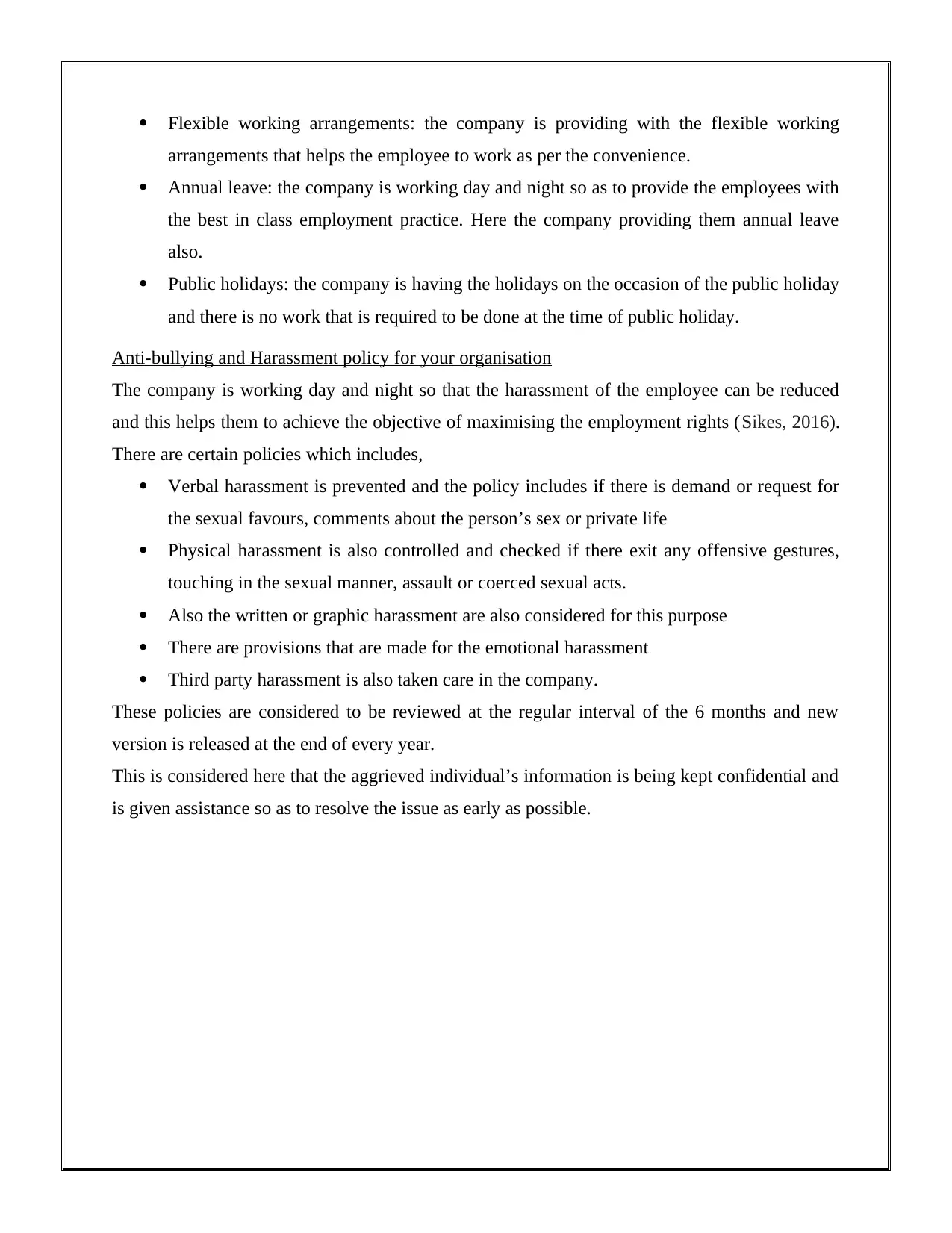
Flexible working arrangements: the company is providing with the flexible working
arrangements that helps the employee to work as per the convenience.
Annual leave: the company is working day and night so as to provide the employees with
the best in class employment practice. Here the company providing them annual leave
also.
Public holidays: the company is having the holidays on the occasion of the public holiday
and there is no work that is required to be done at the time of public holiday.
Anti-bullying and Harassment policy for your organisation
The company is working day and night so that the harassment of the employee can be reduced
and this helps them to achieve the objective of maximising the employment rights (Sikes, 2016).
There are certain policies which includes,
Verbal harassment is prevented and the policy includes if there is demand or request for
the sexual favours, comments about the person’s sex or private life
Physical harassment is also controlled and checked if there exit any offensive gestures,
touching in the sexual manner, assault or coerced sexual acts.
Also the written or graphic harassment are also considered for this purpose
There are provisions that are made for the emotional harassment
Third party harassment is also taken care in the company.
These policies are considered to be reviewed at the regular interval of the 6 months and new
version is released at the end of every year.
This is considered here that the aggrieved individual’s information is being kept confidential and
is given assistance so as to resolve the issue as early as possible.
arrangements that helps the employee to work as per the convenience.
Annual leave: the company is working day and night so as to provide the employees with
the best in class employment practice. Here the company providing them annual leave
also.
Public holidays: the company is having the holidays on the occasion of the public holiday
and there is no work that is required to be done at the time of public holiday.
Anti-bullying and Harassment policy for your organisation
The company is working day and night so that the harassment of the employee can be reduced
and this helps them to achieve the objective of maximising the employment rights (Sikes, 2016).
There are certain policies which includes,
Verbal harassment is prevented and the policy includes if there is demand or request for
the sexual favours, comments about the person’s sex or private life
Physical harassment is also controlled and checked if there exit any offensive gestures,
touching in the sexual manner, assault or coerced sexual acts.
Also the written or graphic harassment are also considered for this purpose
There are provisions that are made for the emotional harassment
Third party harassment is also taken care in the company.
These policies are considered to be reviewed at the regular interval of the 6 months and new
version is released at the end of every year.
This is considered here that the aggrieved individual’s information is being kept confidential and
is given assistance so as to resolve the issue as early as possible.
Secure Best Marks with AI Grader
Need help grading? Try our AI Grader for instant feedback on your assignments.
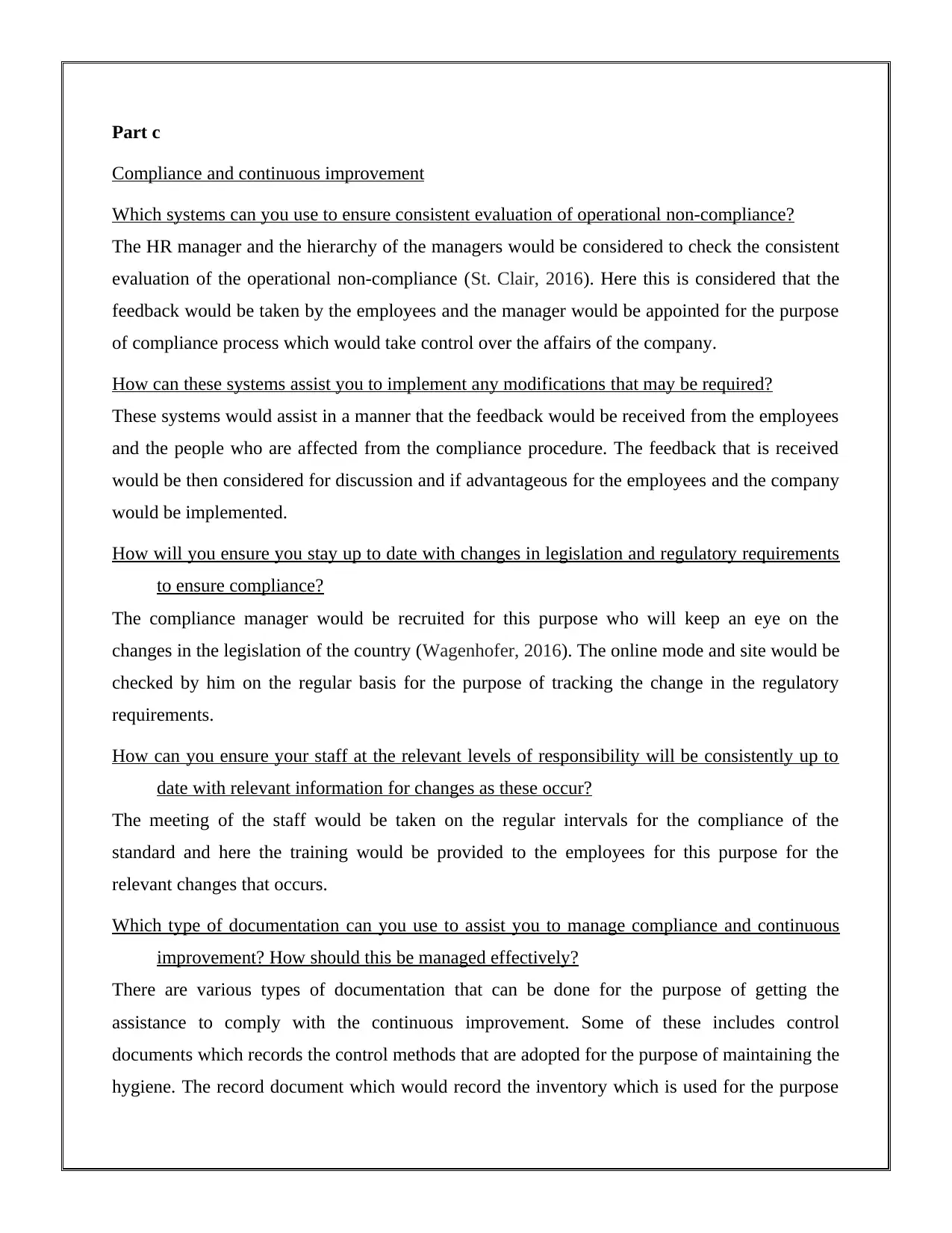
Part c
Compliance and continuous improvement
Which systems can you use to ensure consistent evaluation of operational non-compliance?
The HR manager and the hierarchy of the managers would be considered to check the consistent
evaluation of the operational non-compliance (St. Clair, 2016). Here this is considered that the
feedback would be taken by the employees and the manager would be appointed for the purpose
of compliance process which would take control over the affairs of the company.
How can these systems assist you to implement any modifications that may be required?
These systems would assist in a manner that the feedback would be received from the employees
and the people who are affected from the compliance procedure. The feedback that is received
would be then considered for discussion and if advantageous for the employees and the company
would be implemented.
How will you ensure you stay up to date with changes in legislation and regulatory requirements
to ensure compliance?
The compliance manager would be recruited for this purpose who will keep an eye on the
changes in the legislation of the country (Wagenhofer, 2016). The online mode and site would be
checked by him on the regular basis for the purpose of tracking the change in the regulatory
requirements.
How can you ensure your staff at the relevant levels of responsibility will be consistently up to
date with relevant information for changes as these occur?
The meeting of the staff would be taken on the regular intervals for the compliance of the
standard and here the training would be provided to the employees for this purpose for the
relevant changes that occurs.
Which type of documentation can you use to assist you to manage compliance and continuous
improvement? How should this be managed effectively?
There are various types of documentation that can be done for the purpose of getting the
assistance to comply with the continuous improvement. Some of these includes control
documents which records the control methods that are adopted for the purpose of maintaining the
hygiene. The record document which would record the inventory which is used for the purpose
Compliance and continuous improvement
Which systems can you use to ensure consistent evaluation of operational non-compliance?
The HR manager and the hierarchy of the managers would be considered to check the consistent
evaluation of the operational non-compliance (St. Clair, 2016). Here this is considered that the
feedback would be taken by the employees and the manager would be appointed for the purpose
of compliance process which would take control over the affairs of the company.
How can these systems assist you to implement any modifications that may be required?
These systems would assist in a manner that the feedback would be received from the employees
and the people who are affected from the compliance procedure. The feedback that is received
would be then considered for discussion and if advantageous for the employees and the company
would be implemented.
How will you ensure you stay up to date with changes in legislation and regulatory requirements
to ensure compliance?
The compliance manager would be recruited for this purpose who will keep an eye on the
changes in the legislation of the country (Wagenhofer, 2016). The online mode and site would be
checked by him on the regular basis for the purpose of tracking the change in the regulatory
requirements.
How can you ensure your staff at the relevant levels of responsibility will be consistently up to
date with relevant information for changes as these occur?
The meeting of the staff would be taken on the regular intervals for the compliance of the
standard and here the training would be provided to the employees for this purpose for the
relevant changes that occurs.
Which type of documentation can you use to assist you to manage compliance and continuous
improvement? How should this be managed effectively?
There are various types of documentation that can be done for the purpose of getting the
assistance to comply with the continuous improvement. Some of these includes control
documents which records the control methods that are adopted for the purpose of maintaining the
hygiene. The record document which would record the inventory which is used for the purpose
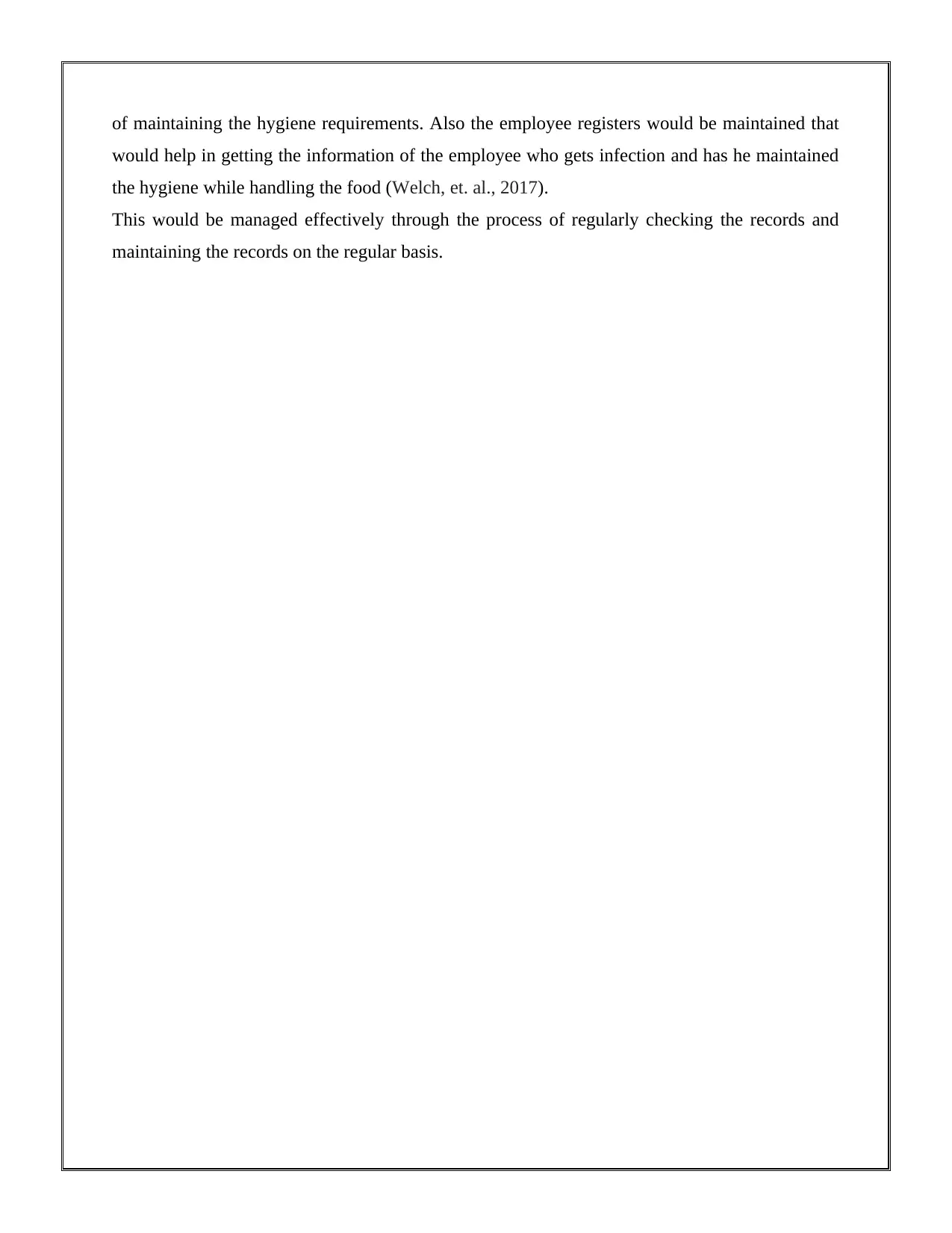
of maintaining the hygiene requirements. Also the employee registers would be maintained that
would help in getting the information of the employee who gets infection and has he maintained
the hygiene while handling the food (Welch, et. al., 2017).
This would be managed effectively through the process of regularly checking the records and
maintaining the records on the regular basis.
would help in getting the information of the employee who gets infection and has he maintained
the hygiene while handling the food (Welch, et. al., 2017).
This would be managed effectively through the process of regularly checking the records and
maintaining the records on the regular basis.
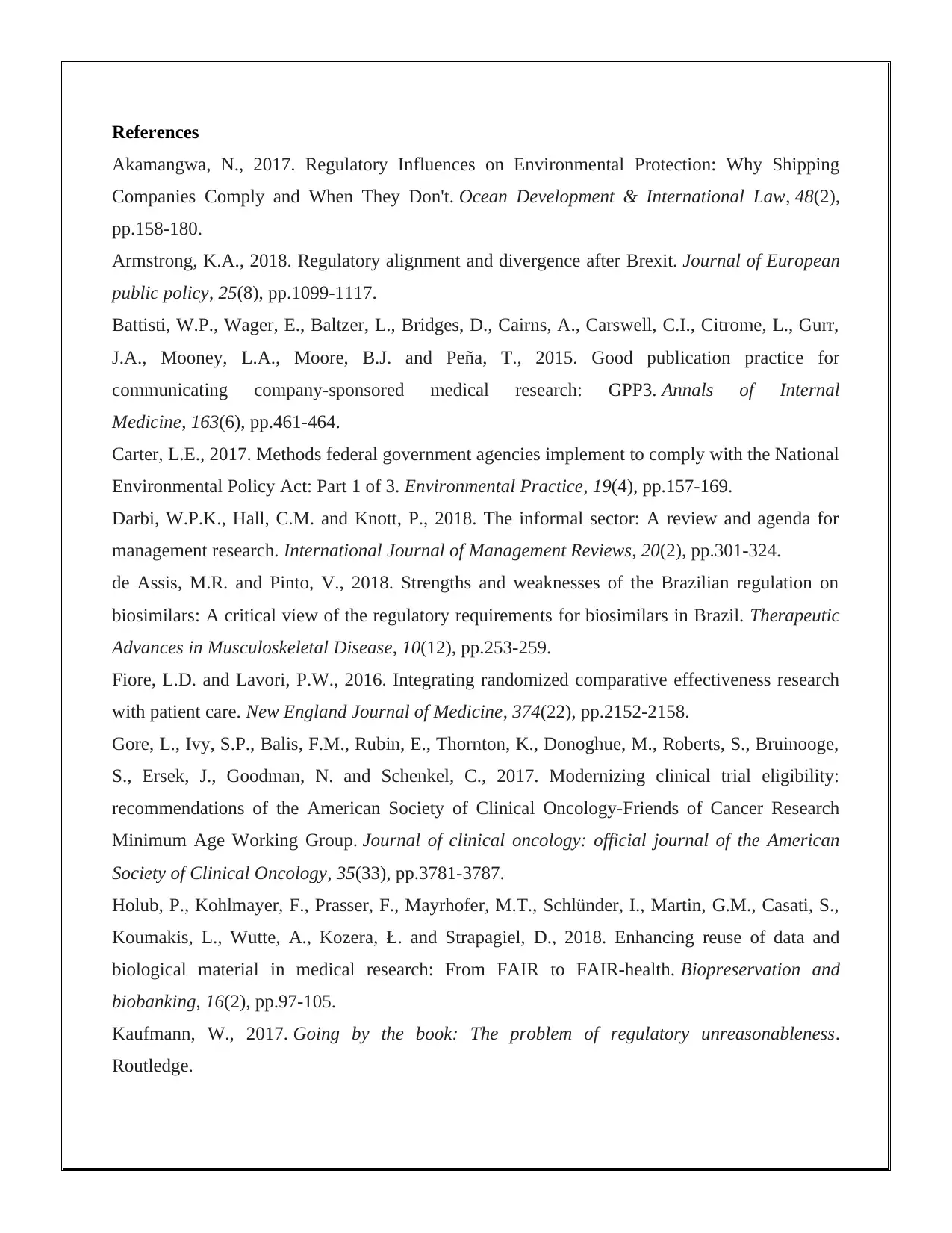
References
Akamangwa, N., 2017. Regulatory Influences on Environmental Protection: Why Shipping
Companies Comply and When They Don't. Ocean Development & International Law, 48(2),
pp.158-180.
Armstrong, K.A., 2018. Regulatory alignment and divergence after Brexit. Journal of European
public policy, 25(8), pp.1099-1117.
Battisti, W.P., Wager, E., Baltzer, L., Bridges, D., Cairns, A., Carswell, C.I., Citrome, L., Gurr,
J.A., Mooney, L.A., Moore, B.J. and Peña, T., 2015. Good publication practice for
communicating company-sponsored medical research: GPP3. Annals of Internal
Medicine, 163(6), pp.461-464.
Carter, L.E., 2017. Methods federal government agencies implement to comply with the National
Environmental Policy Act: Part 1 of 3. Environmental Practice, 19(4), pp.157-169.
Darbi, W.P.K., Hall, C.M. and Knott, P., 2018. The informal sector: A review and agenda for
management research. International Journal of Management Reviews, 20(2), pp.301-324.
de Assis, M.R. and Pinto, V., 2018. Strengths and weaknesses of the Brazilian regulation on
biosimilars: A critical view of the regulatory requirements for biosimilars in Brazil. Therapeutic
Advances in Musculoskeletal Disease, 10(12), pp.253-259.
Fiore, L.D. and Lavori, P.W., 2016. Integrating randomized comparative effectiveness research
with patient care. New England Journal of Medicine, 374(22), pp.2152-2158.
Gore, L., Ivy, S.P., Balis, F.M., Rubin, E., Thornton, K., Donoghue, M., Roberts, S., Bruinooge,
S., Ersek, J., Goodman, N. and Schenkel, C., 2017. Modernizing clinical trial eligibility:
recommendations of the American Society of Clinical Oncology-Friends of Cancer Research
Minimum Age Working Group. Journal of clinical oncology: official journal of the American
Society of Clinical Oncology, 35(33), pp.3781-3787.
Holub, P., Kohlmayer, F., Prasser, F., Mayrhofer, M.T., Schlünder, I., Martin, G.M., Casati, S.,
Koumakis, L., Wutte, A., Kozera, Ł. and Strapagiel, D., 2018. Enhancing reuse of data and
biological material in medical research: From FAIR to FAIR-health. Biopreservation and
biobanking, 16(2), pp.97-105.
Kaufmann, W., 2017. Going by the book: The problem of regulatory unreasonableness.
Routledge.
Akamangwa, N., 2017. Regulatory Influences on Environmental Protection: Why Shipping
Companies Comply and When They Don't. Ocean Development & International Law, 48(2),
pp.158-180.
Armstrong, K.A., 2018. Regulatory alignment and divergence after Brexit. Journal of European
public policy, 25(8), pp.1099-1117.
Battisti, W.P., Wager, E., Baltzer, L., Bridges, D., Cairns, A., Carswell, C.I., Citrome, L., Gurr,
J.A., Mooney, L.A., Moore, B.J. and Peña, T., 2015. Good publication practice for
communicating company-sponsored medical research: GPP3. Annals of Internal
Medicine, 163(6), pp.461-464.
Carter, L.E., 2017. Methods federal government agencies implement to comply with the National
Environmental Policy Act: Part 1 of 3. Environmental Practice, 19(4), pp.157-169.
Darbi, W.P.K., Hall, C.M. and Knott, P., 2018. The informal sector: A review and agenda for
management research. International Journal of Management Reviews, 20(2), pp.301-324.
de Assis, M.R. and Pinto, V., 2018. Strengths and weaknesses of the Brazilian regulation on
biosimilars: A critical view of the regulatory requirements for biosimilars in Brazil. Therapeutic
Advances in Musculoskeletal Disease, 10(12), pp.253-259.
Fiore, L.D. and Lavori, P.W., 2016. Integrating randomized comparative effectiveness research
with patient care. New England Journal of Medicine, 374(22), pp.2152-2158.
Gore, L., Ivy, S.P., Balis, F.M., Rubin, E., Thornton, K., Donoghue, M., Roberts, S., Bruinooge,
S., Ersek, J., Goodman, N. and Schenkel, C., 2017. Modernizing clinical trial eligibility:
recommendations of the American Society of Clinical Oncology-Friends of Cancer Research
Minimum Age Working Group. Journal of clinical oncology: official journal of the American
Society of Clinical Oncology, 35(33), pp.3781-3787.
Holub, P., Kohlmayer, F., Prasser, F., Mayrhofer, M.T., Schlünder, I., Martin, G.M., Casati, S.,
Koumakis, L., Wutte, A., Kozera, Ł. and Strapagiel, D., 2018. Enhancing reuse of data and
biological material in medical research: From FAIR to FAIR-health. Biopreservation and
biobanking, 16(2), pp.97-105.
Kaufmann, W., 2017. Going by the book: The problem of regulatory unreasonableness.
Routledge.
Paraphrase This Document
Need a fresh take? Get an instant paraphrase of this document with our AI Paraphraser
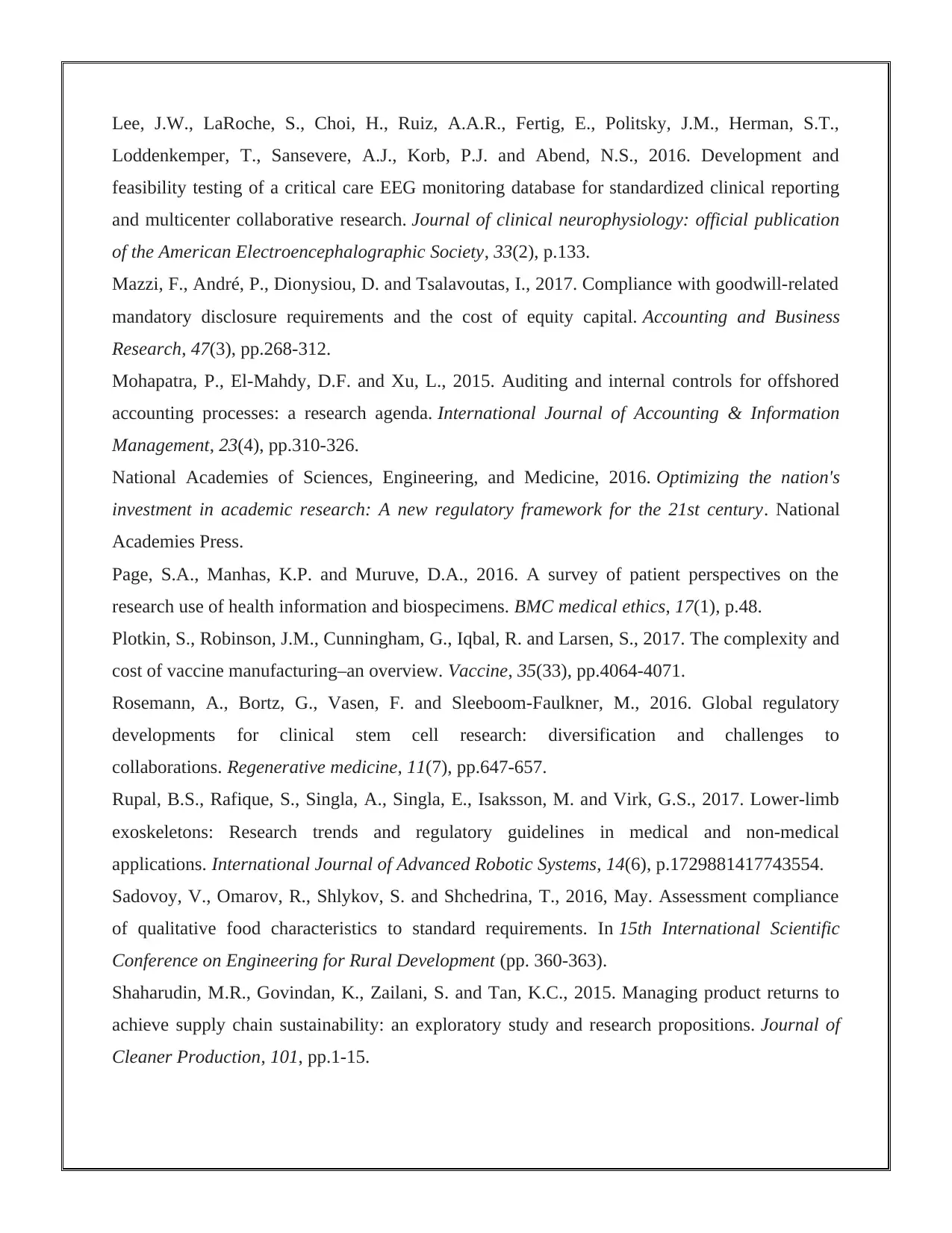
Lee, J.W., LaRoche, S., Choi, H., Ruiz, A.A.R., Fertig, E., Politsky, J.M., Herman, S.T.,
Loddenkemper, T., Sansevere, A.J., Korb, P.J. and Abend, N.S., 2016. Development and
feasibility testing of a critical care EEG monitoring database for standardized clinical reporting
and multicenter collaborative research. Journal of clinical neurophysiology: official publication
of the American Electroencephalographic Society, 33(2), p.133.
Mazzi, F., André, P., Dionysiou, D. and Tsalavoutas, I., 2017. Compliance with goodwill-related
mandatory disclosure requirements and the cost of equity capital. Accounting and Business
Research, 47(3), pp.268-312.
Mohapatra, P., El-Mahdy, D.F. and Xu, L., 2015. Auditing and internal controls for offshored
accounting processes: a research agenda. International Journal of Accounting & Information
Management, 23(4), pp.310-326.
National Academies of Sciences, Engineering, and Medicine, 2016. Optimizing the nation's
investment in academic research: A new regulatory framework for the 21st century. National
Academies Press.
Page, S.A., Manhas, K.P. and Muruve, D.A., 2016. A survey of patient perspectives on the
research use of health information and biospecimens. BMC medical ethics, 17(1), p.48.
Plotkin, S., Robinson, J.M., Cunningham, G., Iqbal, R. and Larsen, S., 2017. The complexity and
cost of vaccine manufacturing–an overview. Vaccine, 35(33), pp.4064-4071.
Rosemann, A., Bortz, G., Vasen, F. and Sleeboom-Faulkner, M., 2016. Global regulatory
developments for clinical stem cell research: diversification and challenges to
collaborations. Regenerative medicine, 11(7), pp.647-657.
Rupal, B.S., Rafique, S., Singla, A., Singla, E., Isaksson, M. and Virk, G.S., 2017. Lower-limb
exoskeletons: Research trends and regulatory guidelines in medical and non-medical
applications. International Journal of Advanced Robotic Systems, 14(6), p.1729881417743554.
Sadovoy, V., Omarov, R., Shlykov, S. and Shchedrina, T., 2016, May. Assessment compliance
of qualitative food characteristics to standard requirements. In 15th International Scientific
Conference on Engineering for Rural Development (pp. 360-363).
Shaharudin, M.R., Govindan, K., Zailani, S. and Tan, K.C., 2015. Managing product returns to
achieve supply chain sustainability: an exploratory study and research propositions. Journal of
Cleaner Production, 101, pp.1-15.
Loddenkemper, T., Sansevere, A.J., Korb, P.J. and Abend, N.S., 2016. Development and
feasibility testing of a critical care EEG monitoring database for standardized clinical reporting
and multicenter collaborative research. Journal of clinical neurophysiology: official publication
of the American Electroencephalographic Society, 33(2), p.133.
Mazzi, F., André, P., Dionysiou, D. and Tsalavoutas, I., 2017. Compliance with goodwill-related
mandatory disclosure requirements and the cost of equity capital. Accounting and Business
Research, 47(3), pp.268-312.
Mohapatra, P., El-Mahdy, D.F. and Xu, L., 2015. Auditing and internal controls for offshored
accounting processes: a research agenda. International Journal of Accounting & Information
Management, 23(4), pp.310-326.
National Academies of Sciences, Engineering, and Medicine, 2016. Optimizing the nation's
investment in academic research: A new regulatory framework for the 21st century. National
Academies Press.
Page, S.A., Manhas, K.P. and Muruve, D.A., 2016. A survey of patient perspectives on the
research use of health information and biospecimens. BMC medical ethics, 17(1), p.48.
Plotkin, S., Robinson, J.M., Cunningham, G., Iqbal, R. and Larsen, S., 2017. The complexity and
cost of vaccine manufacturing–an overview. Vaccine, 35(33), pp.4064-4071.
Rosemann, A., Bortz, G., Vasen, F. and Sleeboom-Faulkner, M., 2016. Global regulatory
developments for clinical stem cell research: diversification and challenges to
collaborations. Regenerative medicine, 11(7), pp.647-657.
Rupal, B.S., Rafique, S., Singla, A., Singla, E., Isaksson, M. and Virk, G.S., 2017. Lower-limb
exoskeletons: Research trends and regulatory guidelines in medical and non-medical
applications. International Journal of Advanced Robotic Systems, 14(6), p.1729881417743554.
Sadovoy, V., Omarov, R., Shlykov, S. and Shchedrina, T., 2016, May. Assessment compliance
of qualitative food characteristics to standard requirements. In 15th International Scientific
Conference on Engineering for Rural Development (pp. 360-363).
Shaharudin, M.R., Govindan, K., Zailani, S. and Tan, K.C., 2015. Managing product returns to
achieve supply chain sustainability: an exploratory study and research propositions. Journal of
Cleaner Production, 101, pp.1-15.
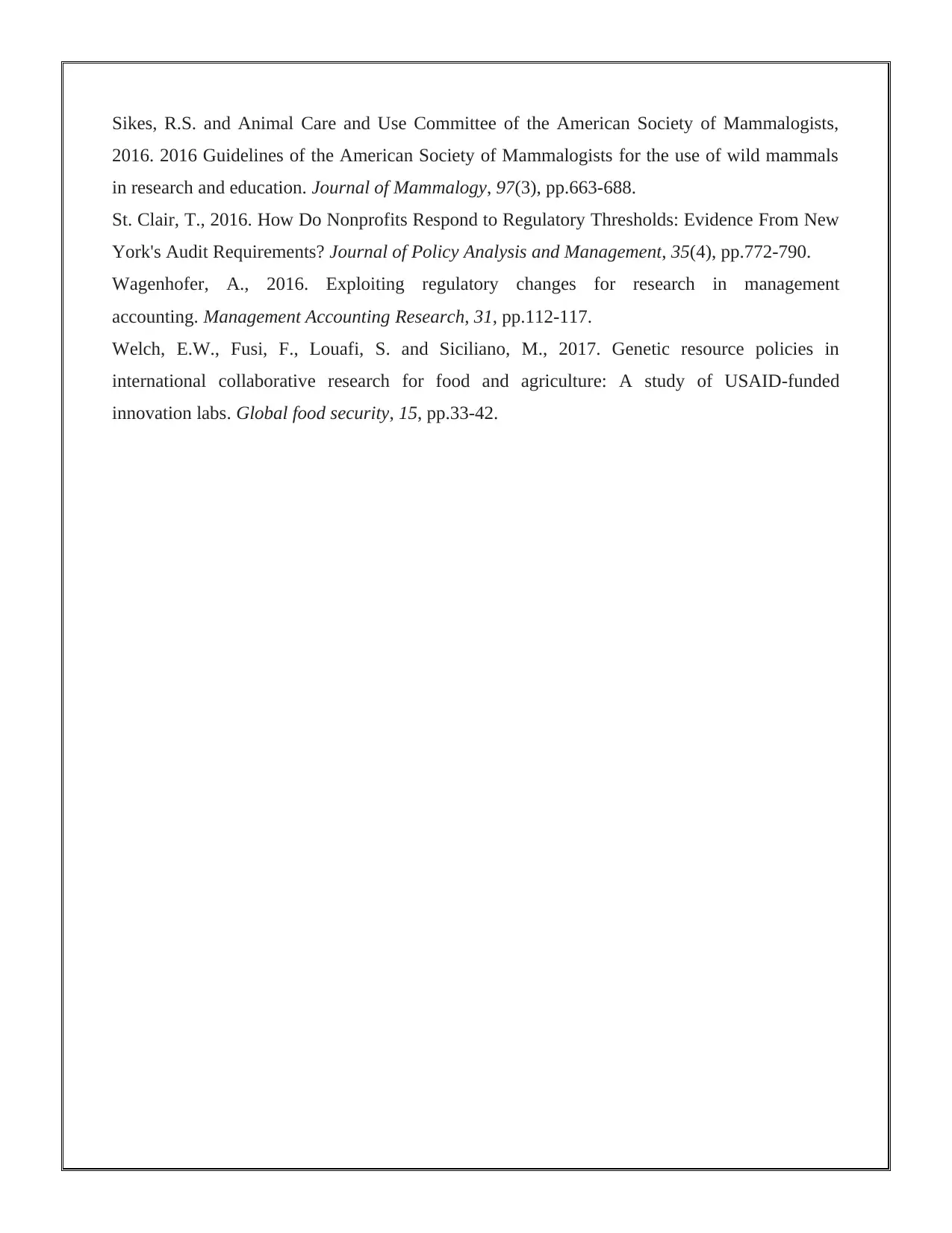
Sikes, R.S. and Animal Care and Use Committee of the American Society of Mammalogists,
2016. 2016 Guidelines of the American Society of Mammalogists for the use of wild mammals
in research and education. Journal of Mammalogy, 97(3), pp.663-688.
St. Clair, T., 2016. How Do Nonprofits Respond to Regulatory Thresholds: Evidence From New
York's Audit Requirements? Journal of Policy Analysis and Management, 35(4), pp.772-790.
Wagenhofer, A., 2016. Exploiting regulatory changes for research in management
accounting. Management Accounting Research, 31, pp.112-117.
Welch, E.W., Fusi, F., Louafi, S. and Siciliano, M., 2017. Genetic resource policies in
international collaborative research for food and agriculture: A study of USAID-funded
innovation labs. Global food security, 15, pp.33-42.
2016. 2016 Guidelines of the American Society of Mammalogists for the use of wild mammals
in research and education. Journal of Mammalogy, 97(3), pp.663-688.
St. Clair, T., 2016. How Do Nonprofits Respond to Regulatory Thresholds: Evidence From New
York's Audit Requirements? Journal of Policy Analysis and Management, 35(4), pp.772-790.
Wagenhofer, A., 2016. Exploiting regulatory changes for research in management
accounting. Management Accounting Research, 31, pp.112-117.
Welch, E.W., Fusi, F., Louafi, S. and Siciliano, M., 2017. Genetic resource policies in
international collaborative research for food and agriculture: A study of USAID-funded
innovation labs. Global food security, 15, pp.33-42.
1 out of 21
Related Documents
Your All-in-One AI-Powered Toolkit for Academic Success.
+13062052269
info@desklib.com
Available 24*7 on WhatsApp / Email
![[object Object]](/_next/static/media/star-bottom.7253800d.svg)
Unlock your academic potential
© 2024 | Zucol Services PVT LTD | All rights reserved.





